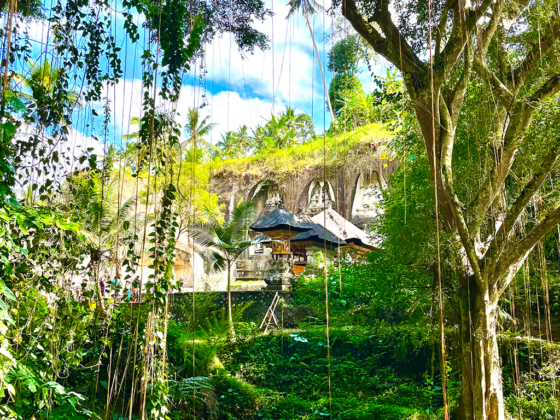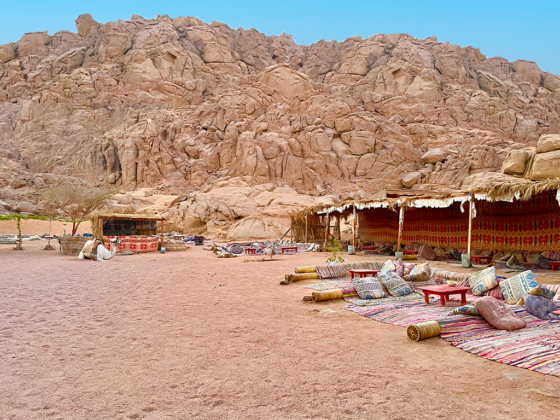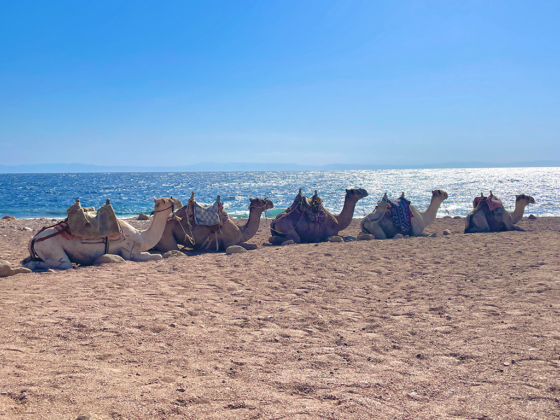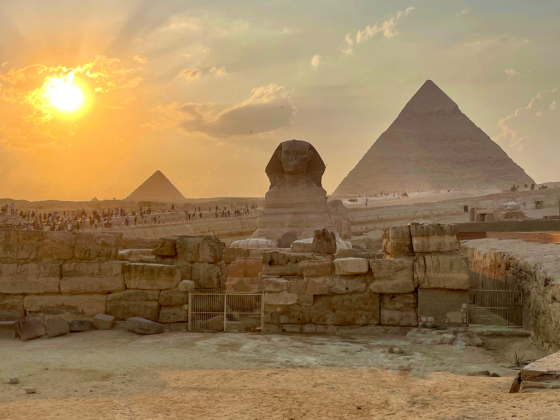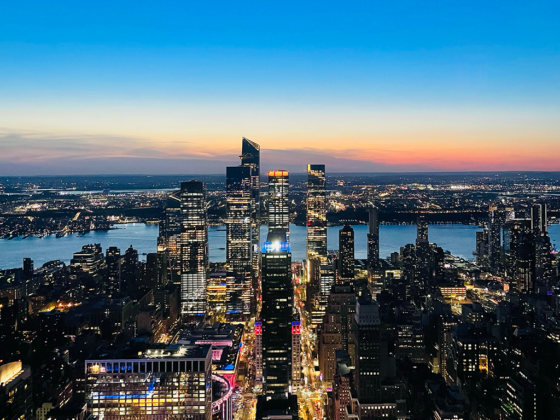Indonesia is a large archipelago of 17,000 islands, each with its own identity, traditions and languages. On this 14-day trip, we explored some of the most famous ones. Prepare your spirits for a journey that will take you to the very heart of the Indonesian essence, including nature, culture and ancient traditions!
- Itinerary in a nutshell
- Day 1: Arrival in Java
- Day 2: Java – Yogyakarta
- Day 3: Java – Borobudur and Prambanan
- Day 4: Java to Bali – Ubud
- Day 5: Bali – Surroundings of Ubud
- Day 6: Bali – the North
- Day 7: Bali – Nusa Penida
- Day 8: Bali – The East
- Day 9: Bali – The South
- Day 10: Bali to Lombok
- Day 11: Lombok – Gili Air
- Day 12: Lombok – Mount Rinjani
- Day 13: Lombok – Tetebatu Panorama Walk
- Day 14: Lombok – Southern Beaches
- Day 15: Lombok – Secret Gili (South West)
- Day 16: Return to Milan
Itinerary in a nutshell
Our itinerary is 14 days long (18 with transfers), four international flights, four internal flights and countless hours of driving through the most diverse landscapes.
We set off from Java, Indonesia’s largest and most populated island. We stopped in Yogyakarta to visit the temples of Borobudur, the largest Buddhist temple ever built, and Prambanan, an impressive Hindu complex, among the most important UNESCO World Heritage sites.
We travelled to Bali visiting rice fields, traditional villages and beaches. We also took a day trip to Nusa Penida, the island of dramatic cliffs.
Our trip ends in Lombok, wilder and less touristy than Bali. The real jewel are the Gili Islands: there are the more famous Gili Trawangan, Gili Meno and Gili Air and the lesser-known ‘Secret Gili’ to the south-west of Lombok, including Gili Asahan, Gili Gede, Gili Layar and Gili Goleng. The crystal-clear waters are ideal for snorkelling and there is the possibility of swimming among sea turtles.
If you are interested in learning more about planning a trip to Indonesia, here are some practical tips.
Day 1: Arrival in Java
We land in Jakarta in the morning and immediately take a new flight to Yogyakarta. From the airport we reach our hotel by private transfer, rest for a while and have dinner in the city.
Day 2: Java – Yogyakarta
We explore Yogyakarta, to recover a little from the trip, work off the jet leg and get our strength back for the next day’s visit.
Leaving the hotel, we are already on Malioboro Street. This famous street is the centre of the city, with its shops, street vendors and artisans selling batiks, jewellery and traditional handicrafts.
We move towards the centre and arrive at the Kraton, the Sultan’s Palace, still inhabited by the current sultan. In the main courtyard is the reception hall, with a marble floor and wooden and gold columns, and the dining room. In the centre is the royal carriage used to carry the princesses on their wedding day. The area dedicated to the sultan’s flats is partly used as a museum. During our visit to the palace, we also attended a performance by Gamelan, an orchestra made up of typical Indonesian instruments: xylophones, gongs, drums and metallophones.
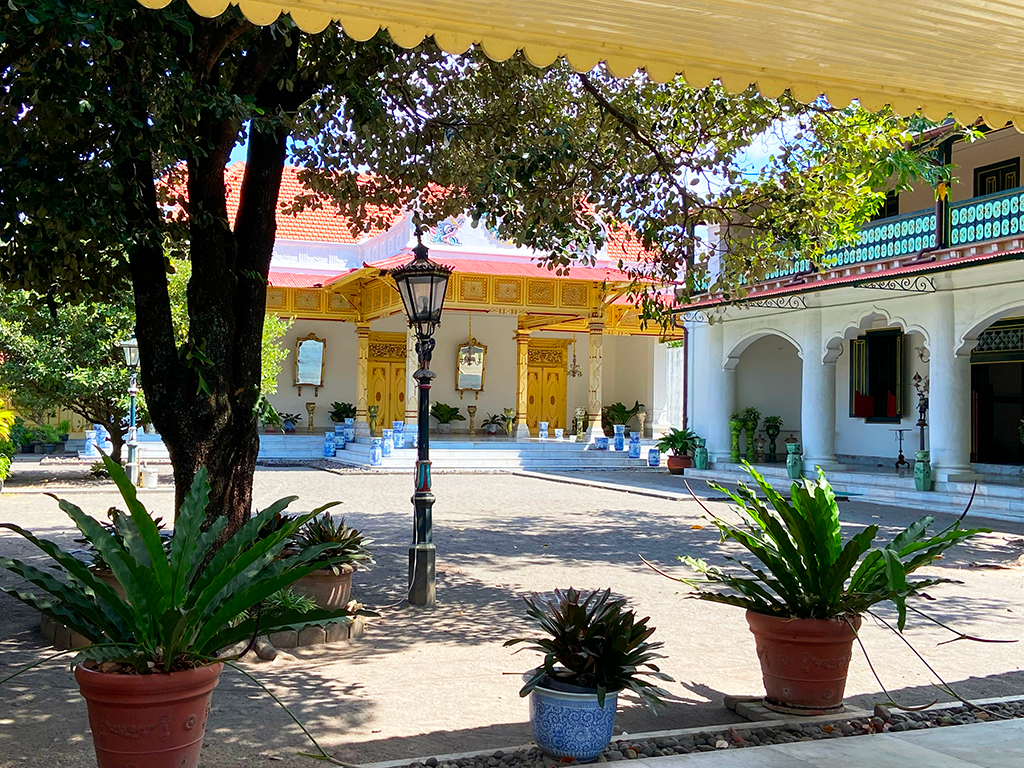
We visit the Taman Sari, known as the Palace of Water. This historic complex was the private retreat of the sultan and his family, intended for relaxation and meditation. Today, it remains a fascinating network of pools, secret passages and pavilions, shrouded in a mysterious and ancient atmosphere.
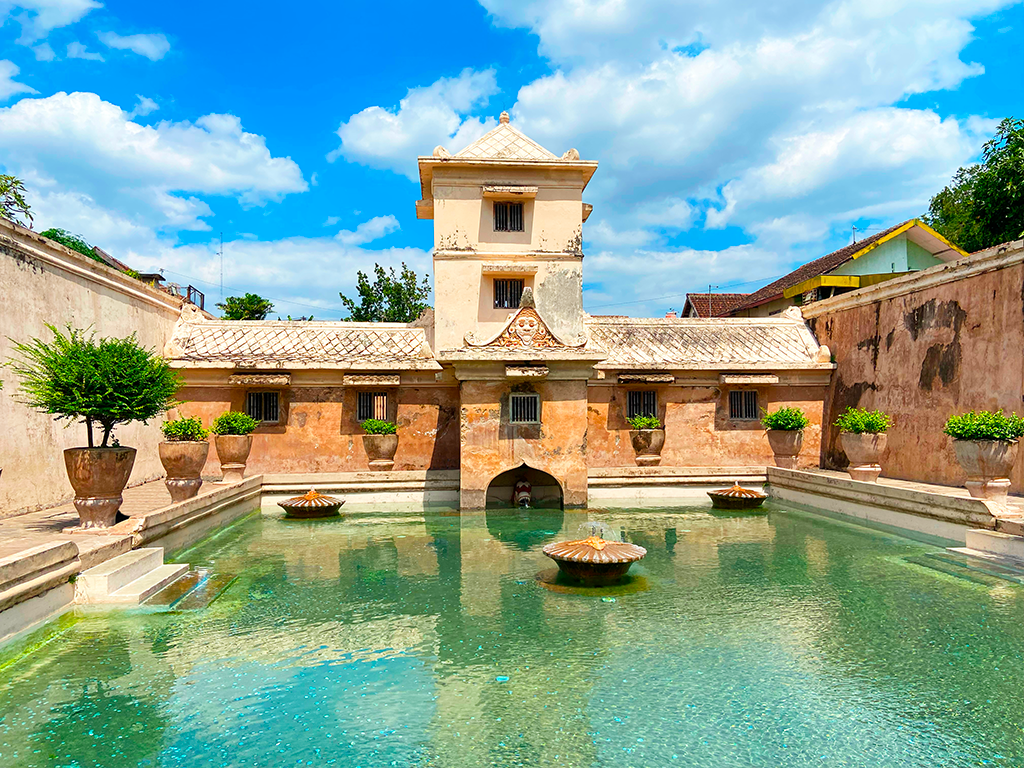
We head back to Malioboro Street to visit Pasar Beringharjo, one of Yogyakarta’s oldest and most famous covered markets. In the front – the newer part – you will find mostly clothing, from traditional batik to vibrantly coloured accessories and textiles to handicrafts, typical of the place. In the back – the older and more characteristic part – one finds a wide variety of foodstuffs, fruit and vegetables, spices and natural remedies.
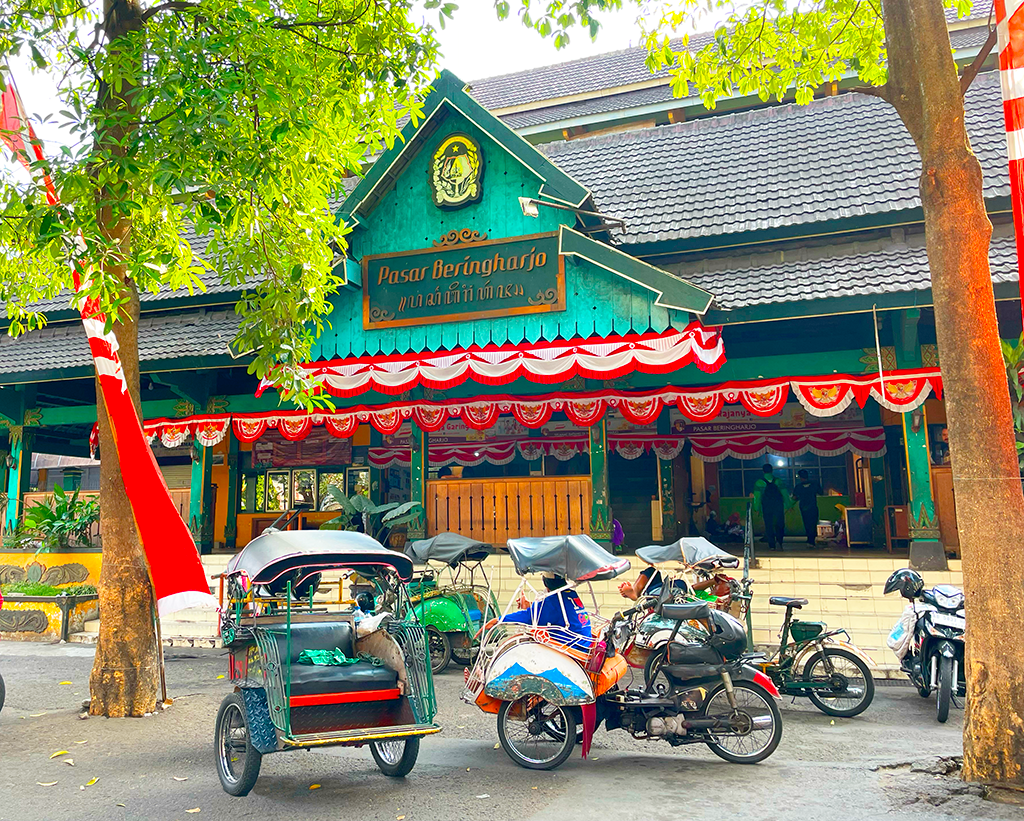
Day 3: Java – Borobudur and Prambanan
The reason we stopped in Yogyakarta is the proximity to the temples of Borobudur and Prambanan, among the most important UNESCO World Heritage sites. Considering that they are located in opposite directions from the city, which is almost in the middle – Borobudur is about 40 km away, Prambanan 20 km – to visit both in one day, we opted for an organised tour.
Tips for Trips: Online you will find many options for tours to both individual temples and combination tours, which allow you to visit Borobudur and Prambanan in one day. The important thing is to check what is included in the tour: often, the cheapest tours only include transport, but not entrance fees. If you are travelling in high season, it is best to buy at least a ticket in advance to climb the upper terraces of Borobudur (with restricted entry) unless the tour clearly specifies that tickets are included.
We begin with the Borobudur temple, the largest Buddhist temple in the world and one of the most visited sites in Indonesia. Built around 800 A.D., it consists of six square platforms topped by three circular platforms, covered with 2,672 carved panels and 504 statues of the Buddha protected within the stupas that decorate the top of the temple. Today, access to the upper levels of the temple is restricted to preserve the site: only 150 people per hour are allowed on the upper terraces accompanied by a guide, with flip-flops provided at the entrance.
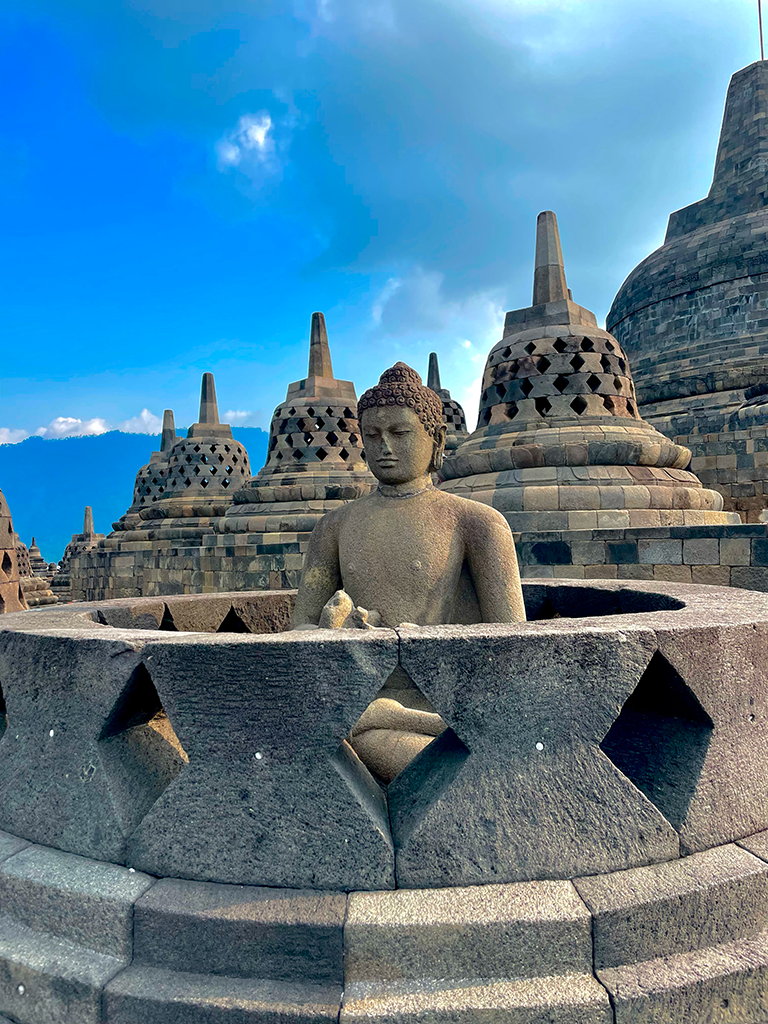
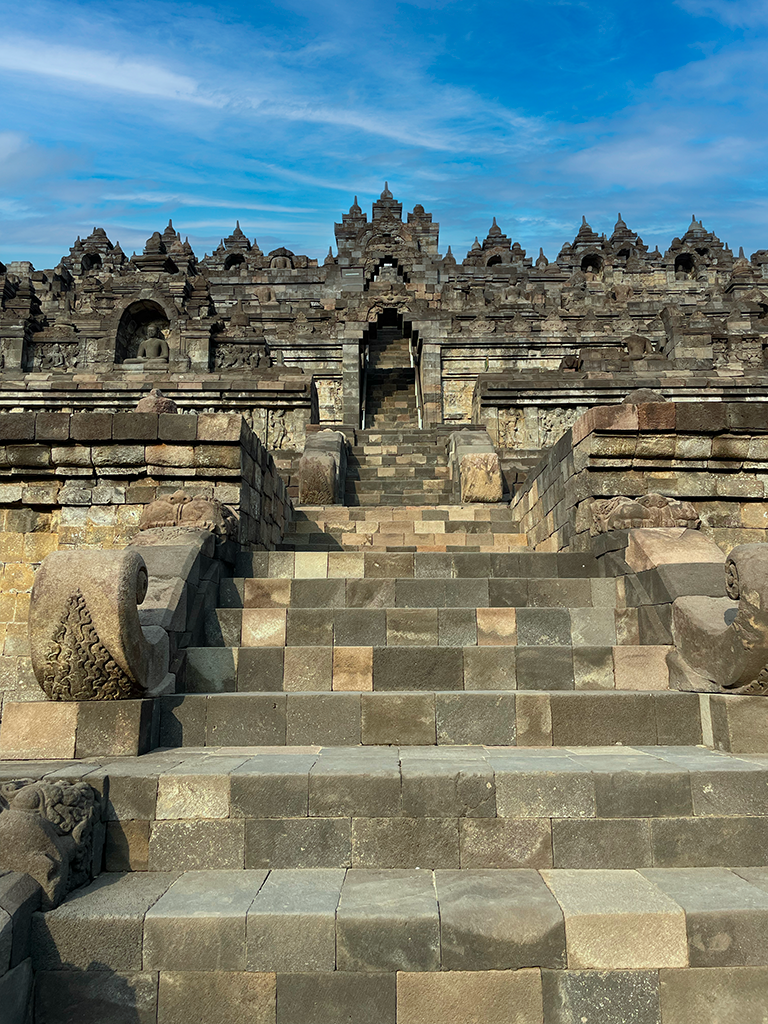
Before leaving the Borobudur area, our guide makes us stop at the nearby temples of Pawon and Mendut, both linked to the great Borobudur complex and part of a Buddhist ritual path.
The Pawon Temple, located about 2 km from Borobudur, is a small shrine with details carved from volcanic stone. A short distance away is the Temple of Mendut, where a monumental statue of the Buddha stands three metres high, depicted in a seated position and surrounded by two other figures from the Buddhist pantheon.
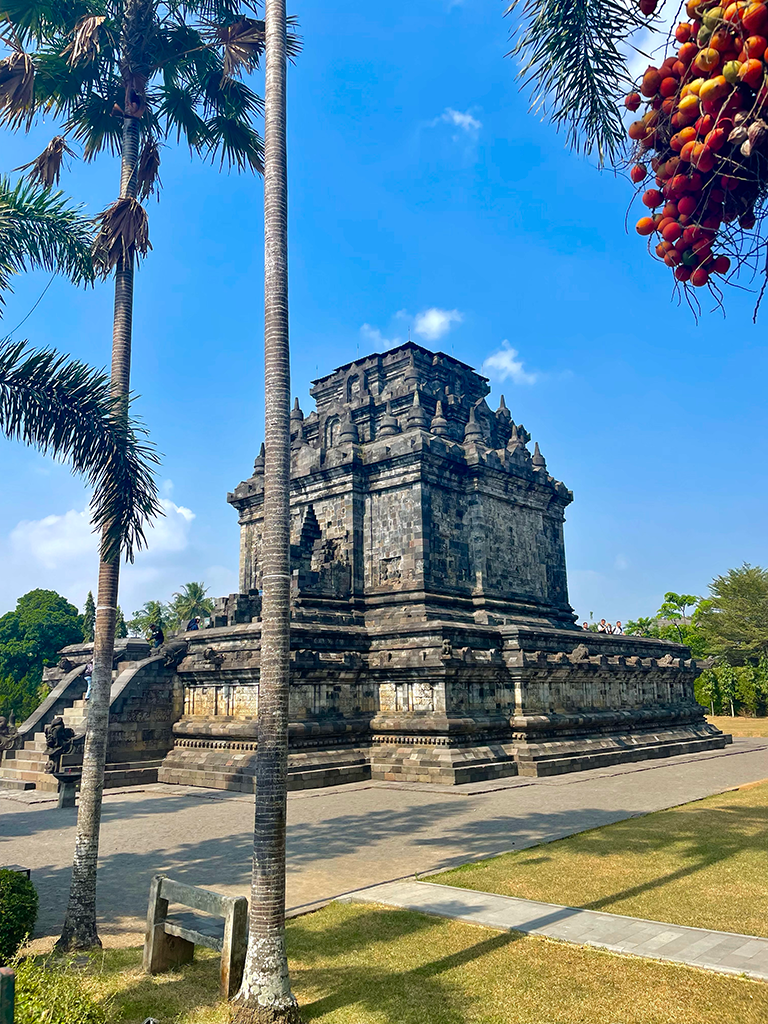
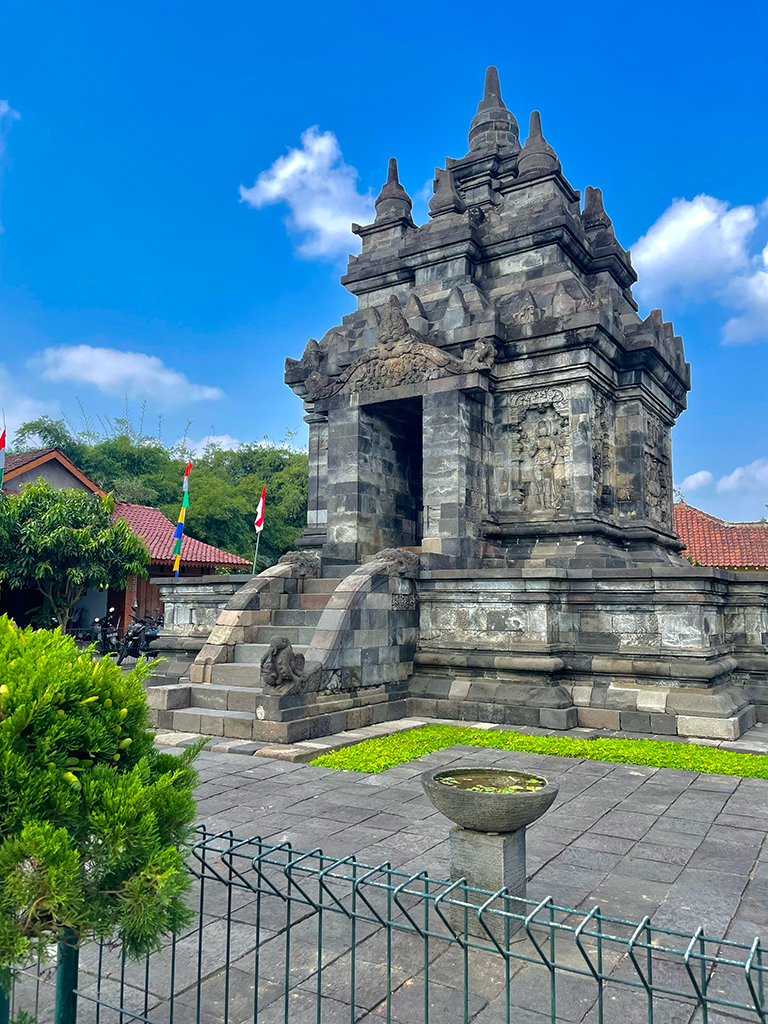
We move on to Prambanan Temple, the largest Hindu temple complex in Indonesia. Built around 800 AD, the site is dedicated to the triad of Hindu gods: Brahma, Vishnu and Shiva. The main temple, dedicated to Shiva, is 47 metres high. The architecture of the entire complex is incredibly detailed, with bas-reliefs telling the stories of the ‘Ramayana’ and other Hindu legends. Surrounding it are numerous smaller temples, many of which are still being restored.
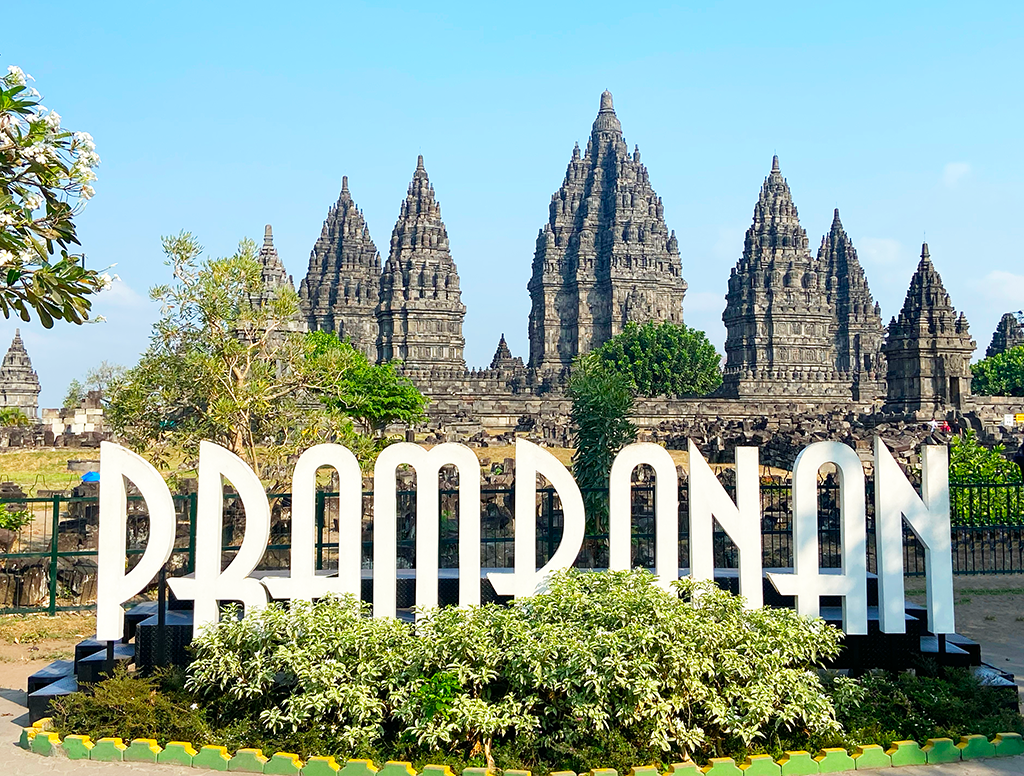
Day 4: Java to Bali – Ubud
First day of travel from Yogyakarta to Bali. We land in Denpasar and head straight for Ubud, considered the heart of the island.
After settling into our hotel we decide to start exploring the city straight away, and our first stop is the Ubud Market, a veritable kaleidoscope of colours, smells and sounds. We stroll among the stalls: from batik fabrics, characterised by intricate designs and bright colours, to handmade jewellery with beads and natural stones, to carved wooden objects and traditional Balinese masks.
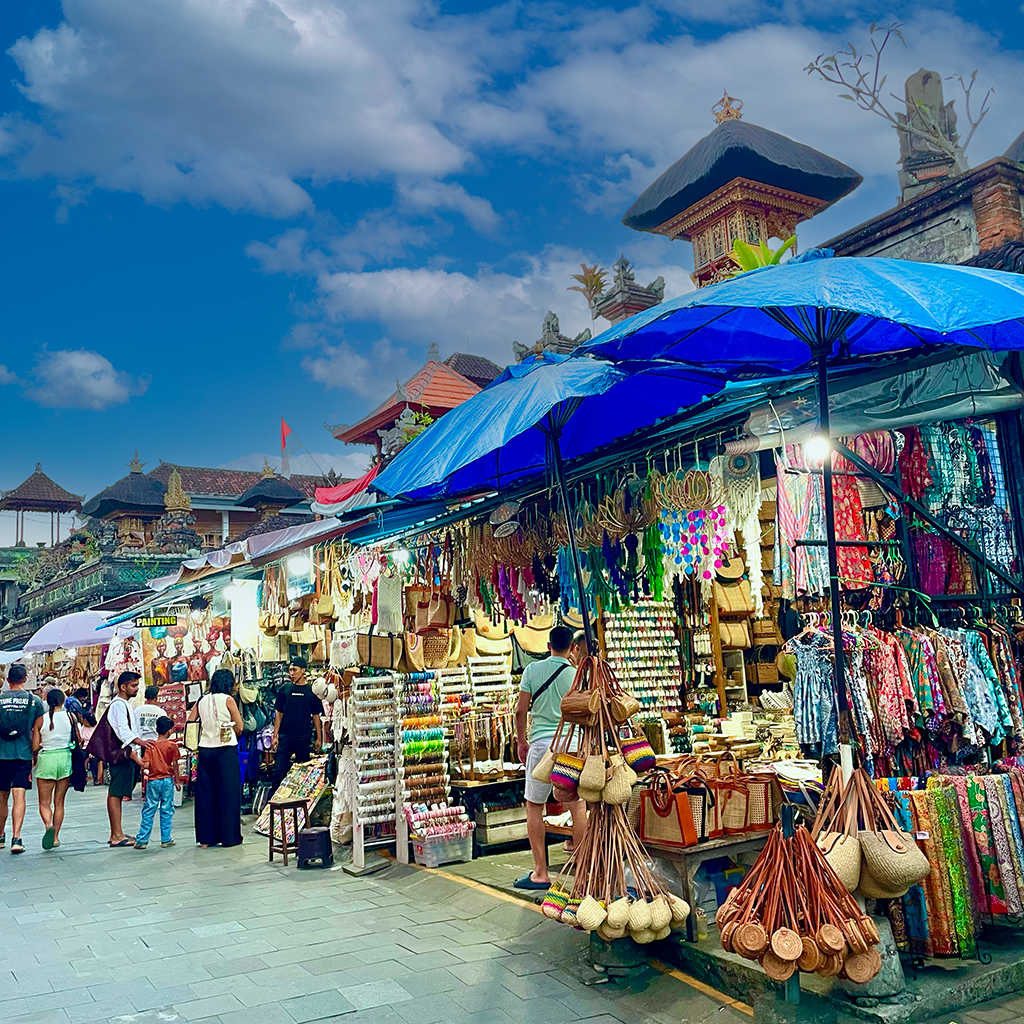
We visit the nearby Royal Palace of Ubud (Puri Saren Agung). This palace, once home to the Ubud royal family, is a perfect example of traditional Balinese architecture, with its intricate wood carvings and stone sculptures decorating the portals and walls.
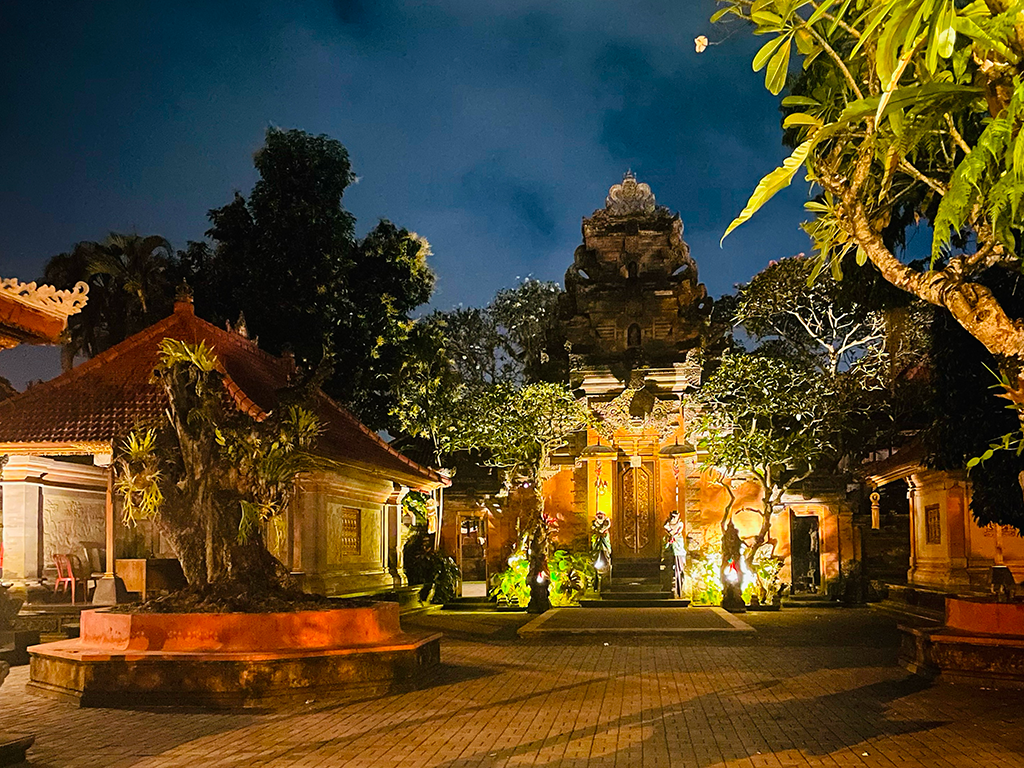
Not far away is the Saraswati Temple, dedicated to the Hindu goddess of wisdom and the arts. This temple is famous for its beautiful lotus pond. We visit it when it is practically evening (we were lucky because we found it at the extraordinary evening opening): it is a marvellous play of water and lights, the footbridge that crosses the pond takes us to the entrance of the temple, lit up in gold creating a magical effect. I think it is one of the most beautiful places to visit in Ubud.
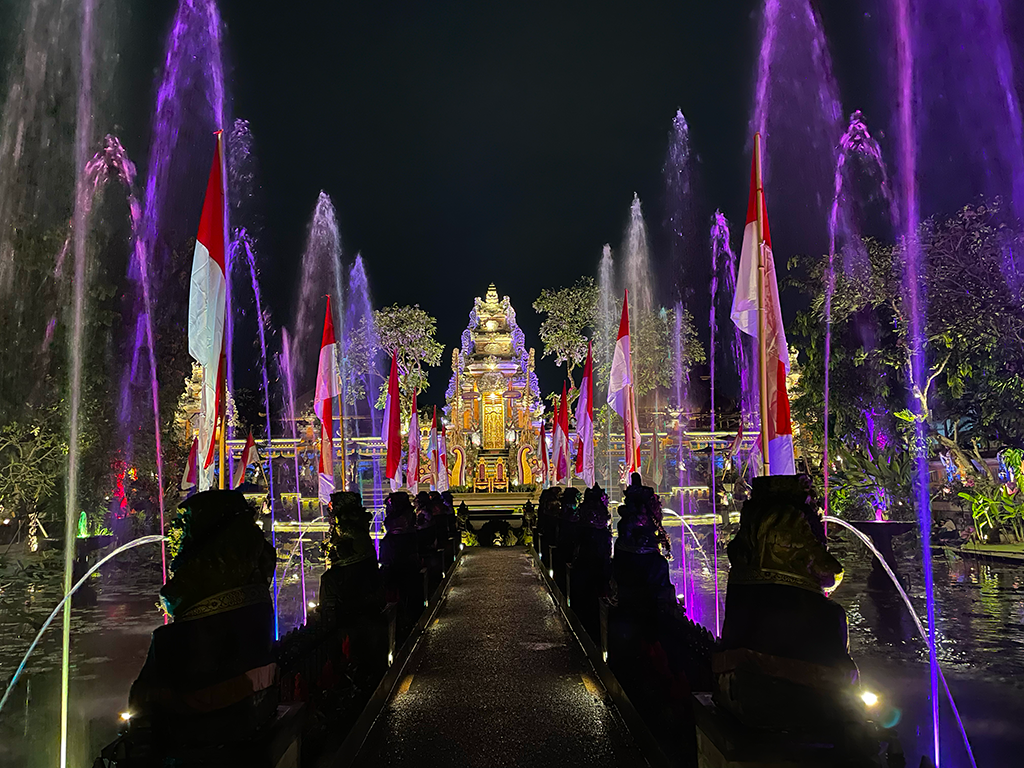
Right next to the temple, we notice a restaurant that overlooks the pond. Without hesitation, we ask for a table and sit down. We dine and enjoy the view of the temple and the illuminated pond.
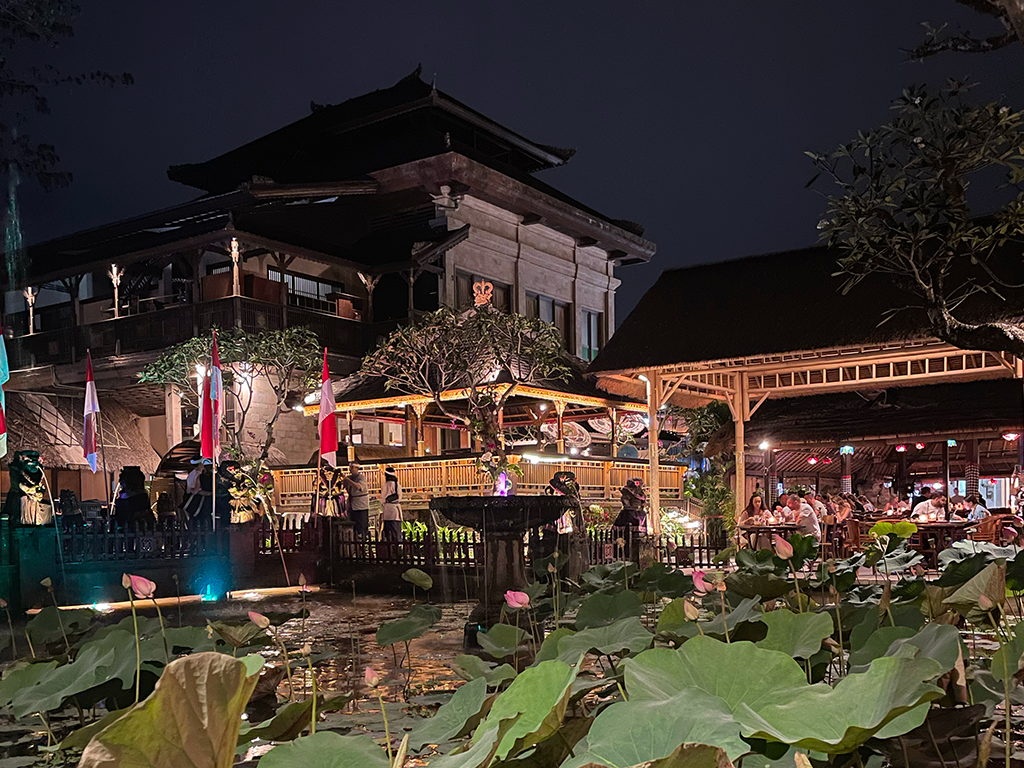
Day 5: Bali – Surroundings of Ubud
Today we dedicate ourselves to the surroundings of Ubud. Our day begins with a visit to the famous Tegalalang rice paddies, verdant terraces winding along the hills. The view is impressive. We are a little disappointed by the massive exploitation for tourism, at every corner there are selfie stations: swings, fake nests, bamboo hearts. Some authenticity is lost.
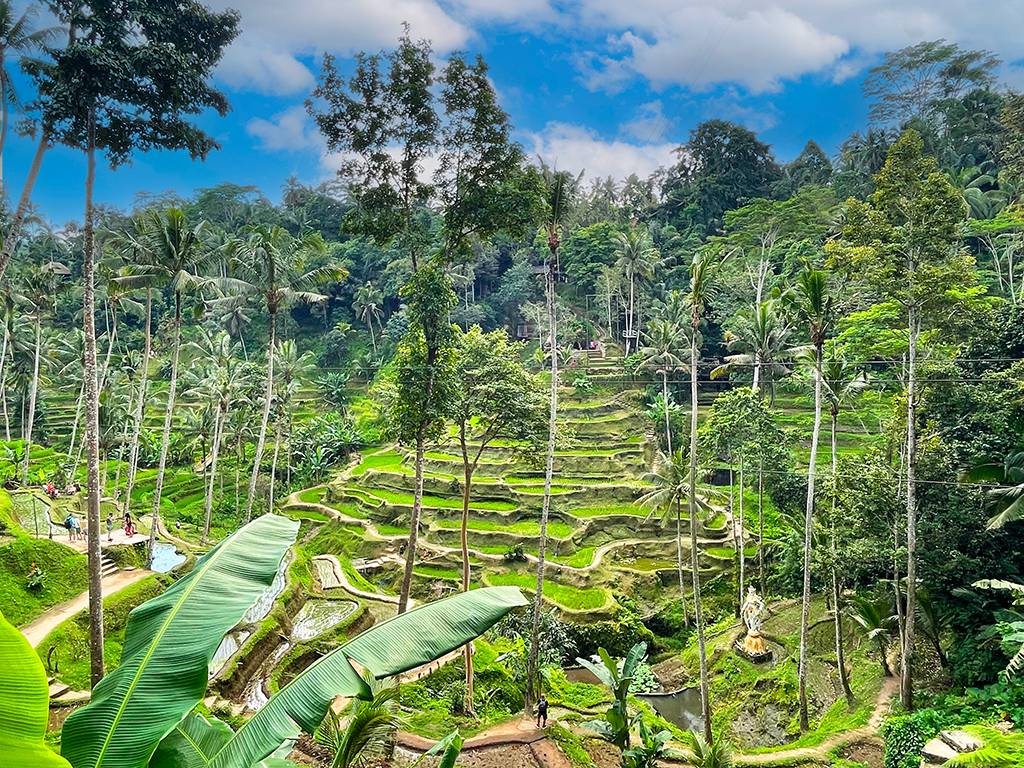
We continue on to the Tibumana waterfalls. Here, in a corner of pristine jungle, water flows down a rock face, forming a tranquil waterfall that plunges into a natural pool.
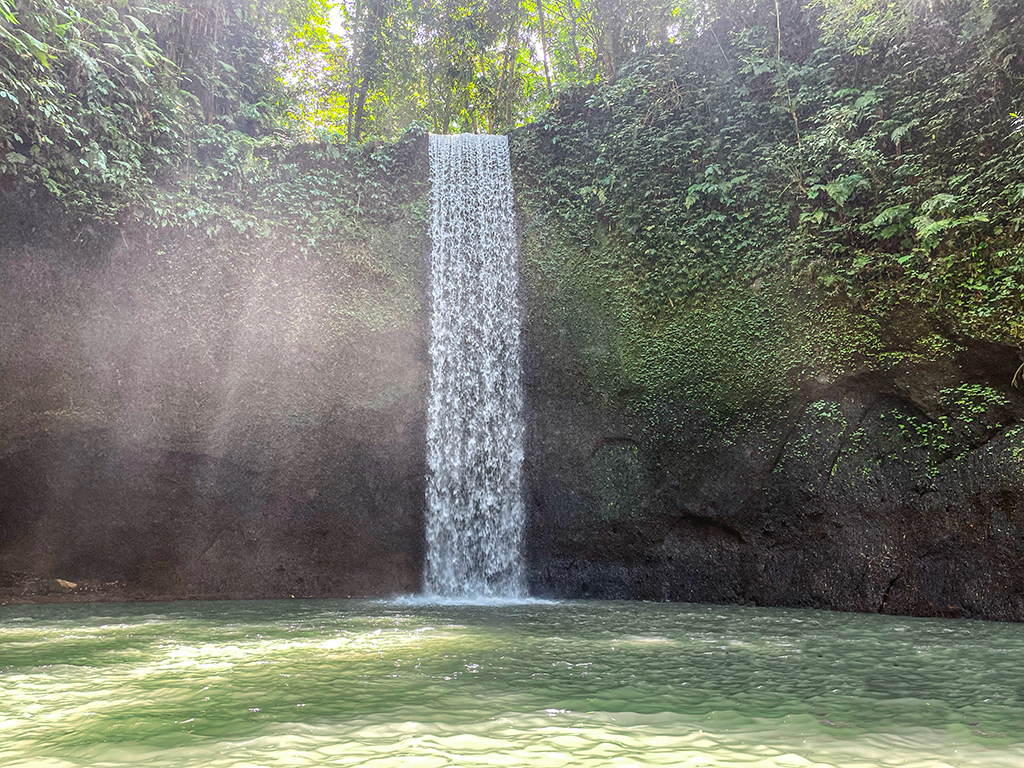
In the afternoon, we move on to the Gunung Kawi Archaeological Site, a place that looks like something out of a movie, beautiful. This ancient temple complex is carved directly into the rock and is surrounded by lush forest. One of the most beautiful sites in Bali.
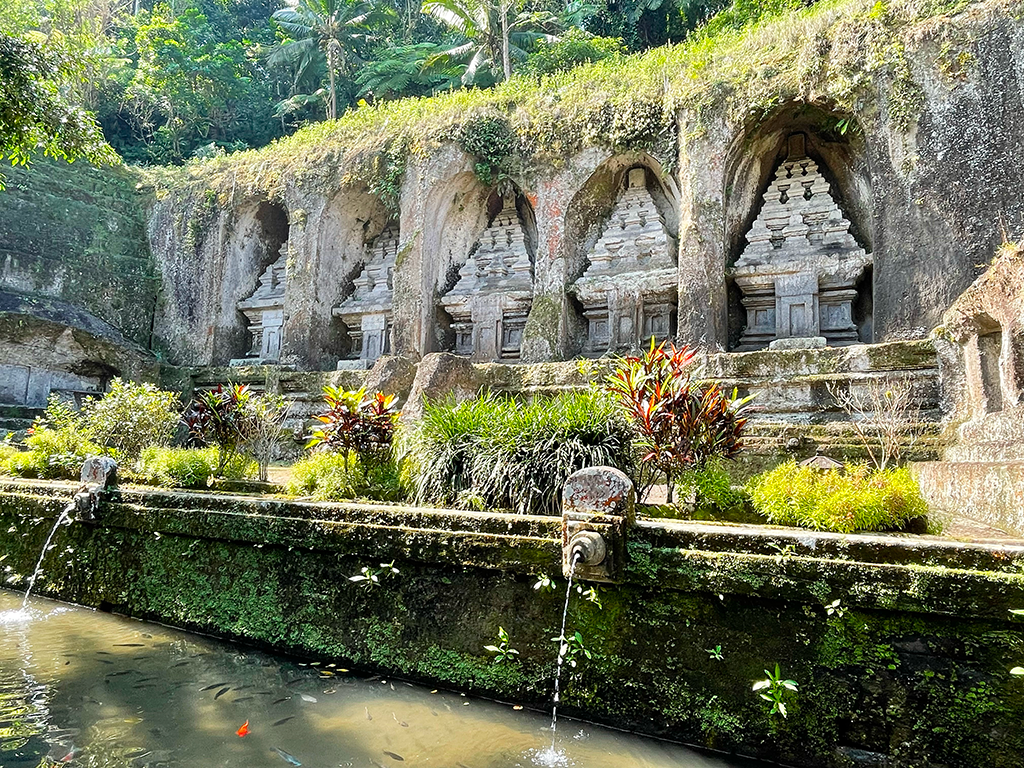
We arrive at Tirta Empul. The complex is divided into several sections, with ornate courtyards, stone pools and intricate Balinese sculptures that tell the story of local history and mythology. The most iconic part of Tirta Empul are the purification pools.
Here, the faithful immerse themselves in the sacred waters flowing from the temple fountains to perform a purification ritual. Unfortunately, even this loses some of its authenticity due to a parade of tourists ready to perform a ritual whose meaning they do not understand just to take a few selfies while freezing in a hopeful green dress.
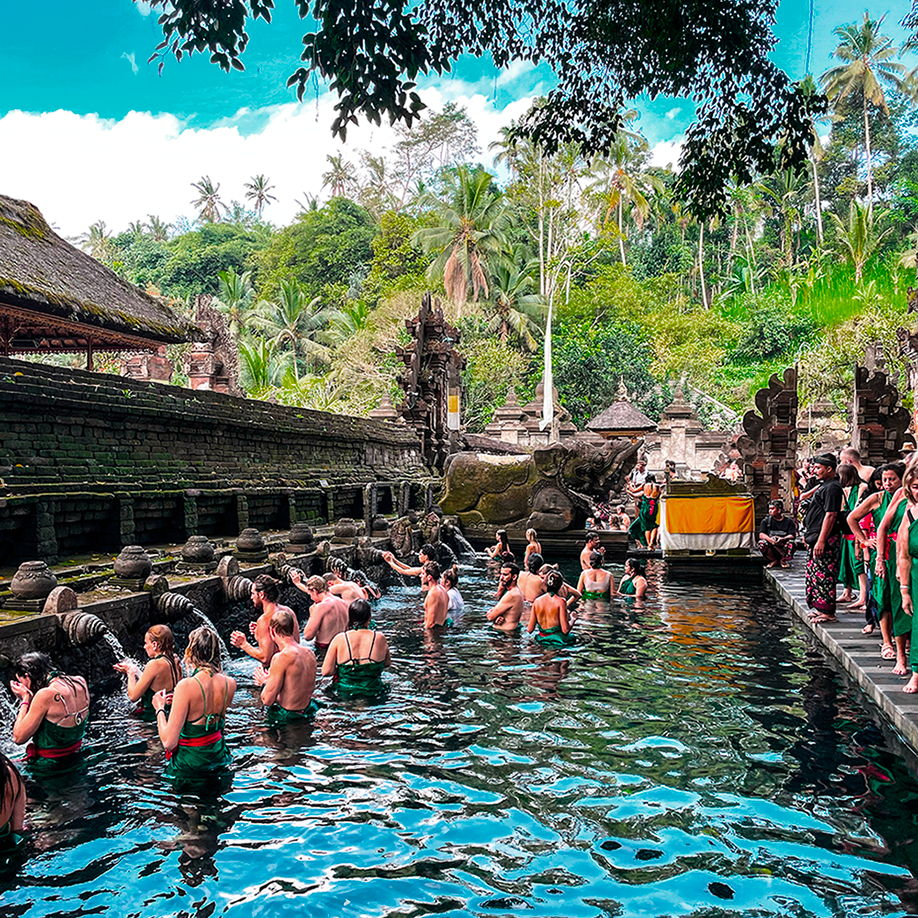
We return to Ubud and visit the Ubud Monkey Forest, a sanctuary that is home to hundreds of monkeys. We stroll along the paths as the monkeys hop from tree to tree, play tricks around the stalls and approach visitors curiously. We do not find them very friendly but they are beautiful to watch.
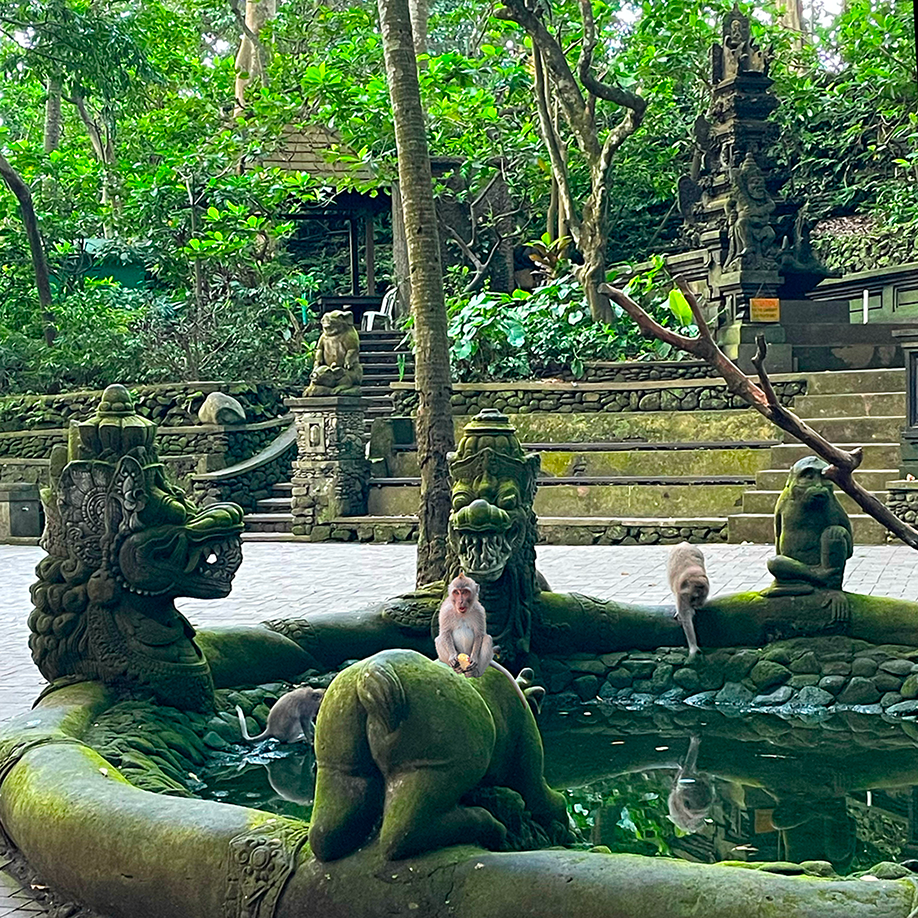
Day 6: Bali – the North
Today we dedicate ourselves to the north of the island. Our first stop is at Leke Leke Falls. After a short walk along a path through the heart of the tropical forest, the sound of the rushing water becomes more and more intense until we are in front of the waterfall: the water falls from a dizzying height, framed by a wall of green vegetation.
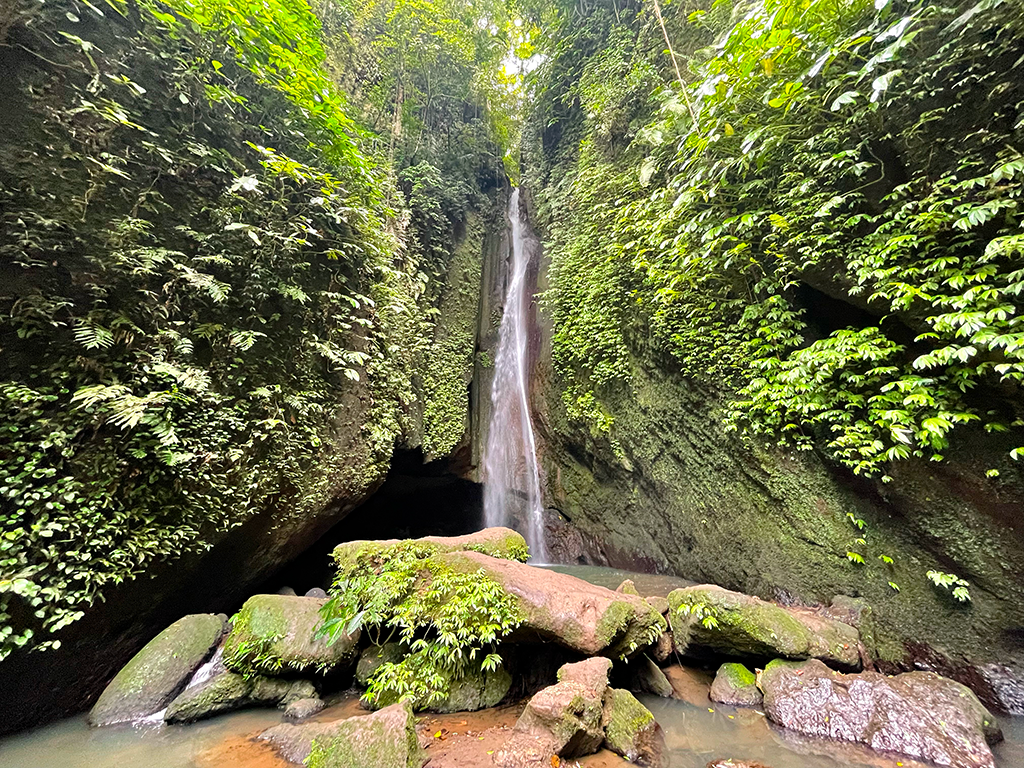
We continue to one of the most majestic waterfalls on the island: the Banyumala Waterfall. Unlike other waterfalls, it has two streams that slide parallel along a moss-covered rock face, creating a unique scenic effect. Here it is possible to bathe, lie in the shade or walk along the paths leading to other small waterfalls nearby.
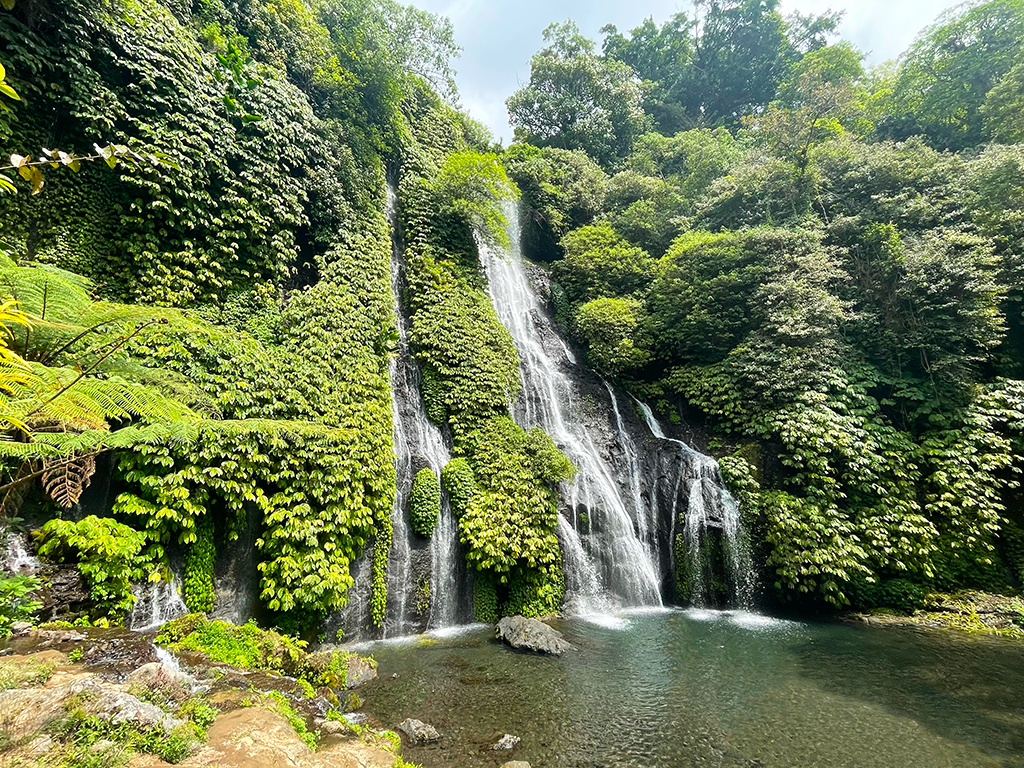
We make our way back to one of Bali’s most iconic attractions: the Ulun Danu Bratan Temple. Located on a small island that seems to float on the calm waters of Lake Bratan, this temple dedicated to the water goddess Dewi Danu is surrounded by an almost ethereal atmosphere. When we arrive, the fog creates a mystical aura around the temple and makes everything even more spiritual. When the fog descends, the colours are dazzling.
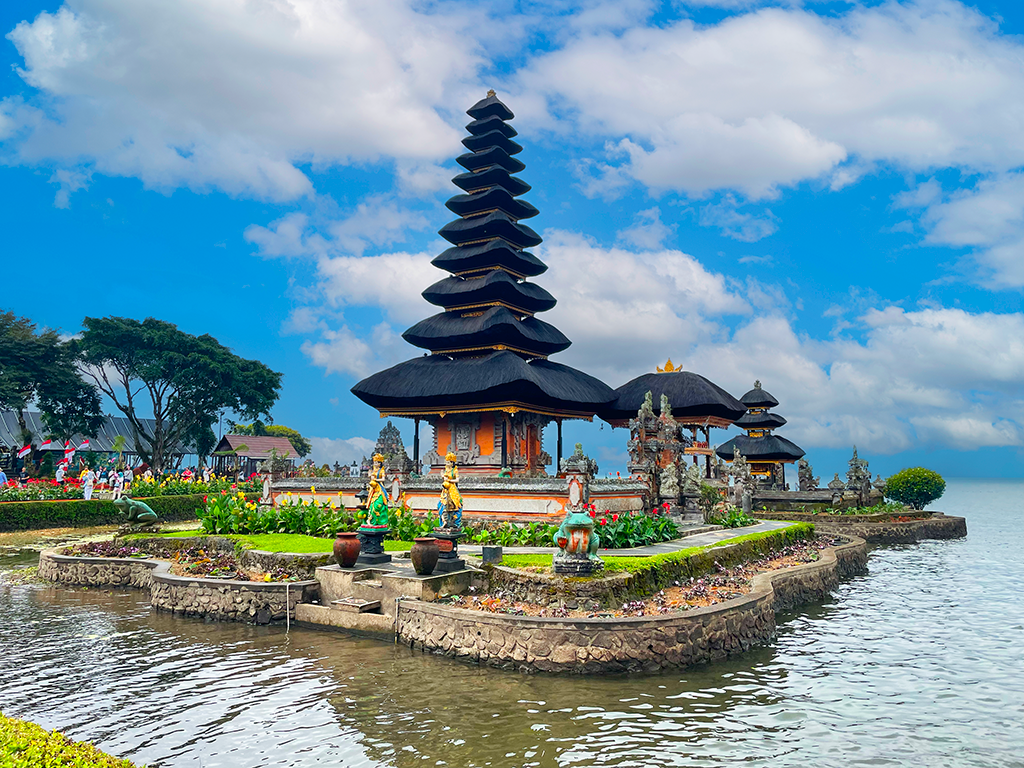
We end the day exploring the beautiful Jatiluwih Rice Fields, Bali’s authentic rice fields, a UNESCO World Heritage site. The rice terraces here stretch as far as the eye can see. The green hills are precisely drawn, shaped by Balinese farmers according to a traditional irrigation system called subak, which has existed for centuries.
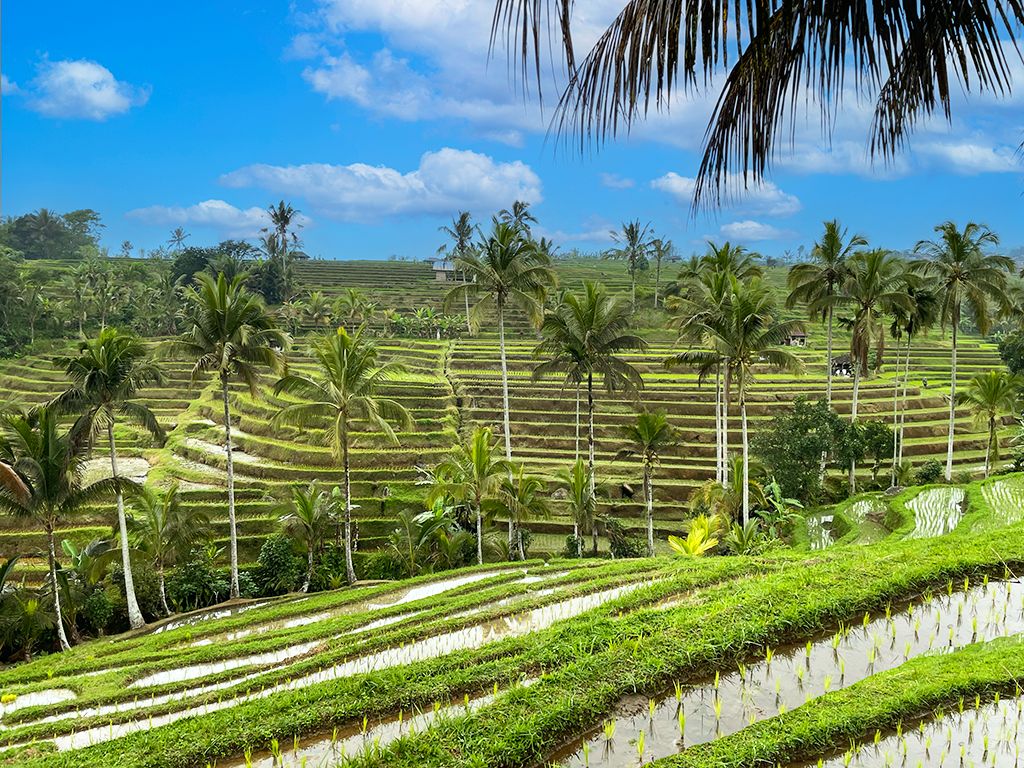
Day 7: Bali – Nusa Penida
Today we venture to the island of Nusa Penida, a natural paradise a short distance from Bali. We have booked a private tour with a fast boat and driver that will take us around the island.
Trip or Trips: Nusa Penida is definitely worth a visit, the places are wonderful but… we did the day tour and, maybe it was the hurried driver, maybe it was the bumpy roads, maybe it was the previous tiredness, we didn’t particularly enjoy the day. I would recommend at least two days’ rest if you don’t want to risk a ‘photograph and away’ tour!
The first stop is Angel’s Billabong, a natural pool of truly crystal-clear water situated in a rocky cliff. The rocks surrounding the pool create colour contrasts between the emerald green of the water and the dark grey of the volcanic rocks. The view of the open ocean is spectacular.
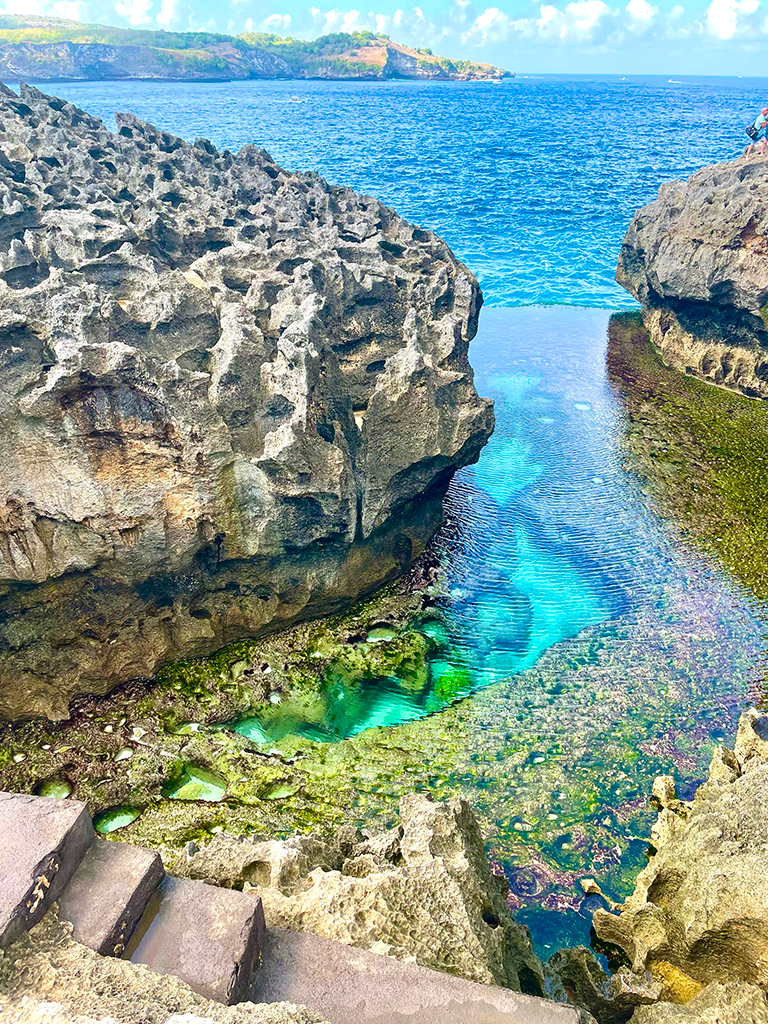
A short distance away is Broken Beach (Pasih Uug), a huge bay surrounded by high cliffs, famous for its natural arch overlooking the ocean. This arch is what remains of an ancient cave that collapsed over time, forming a natural pool enclosed by the sea. The turquoise waters contrast with the brown rocks, creating a picture-postcard scenery, while the cliffs offer perfect vantage points. We even managed to see a huge manta ray in the waters below.
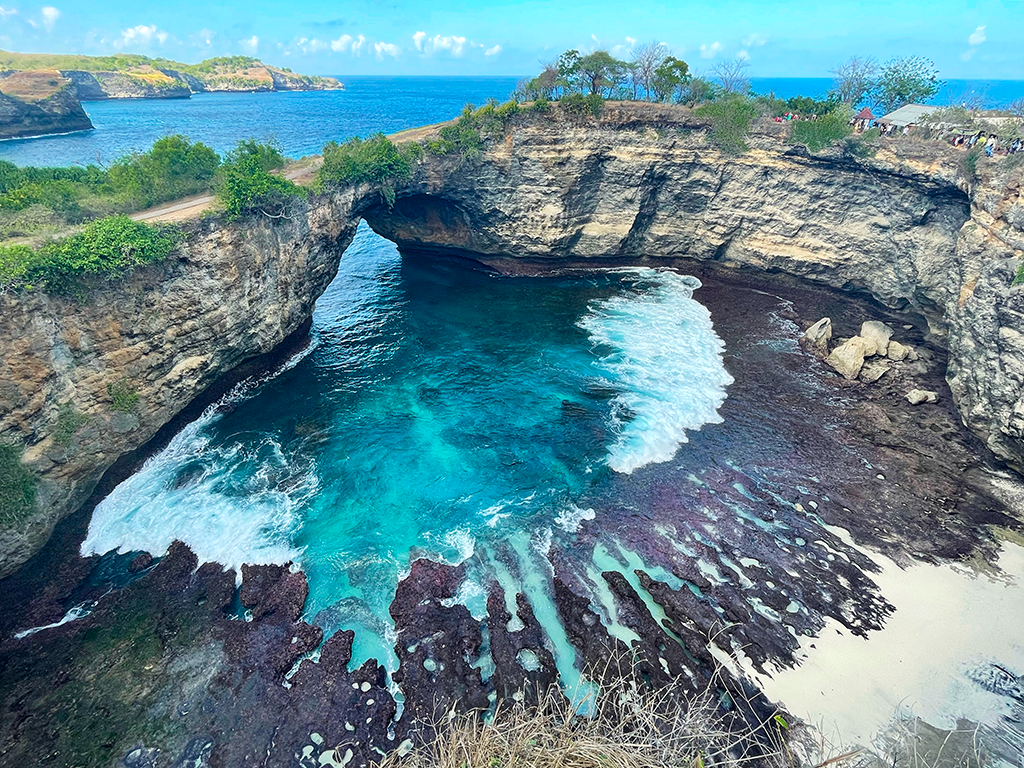
We continue on to Kelingking Beach, famous for its T-Rex-shaped cliffs jutting out into the ocean. From a high promontory, there is an incredible panoramic view of the beach, nestled between high cliffs, with fine white sand and turquoise waters lapping the shore.
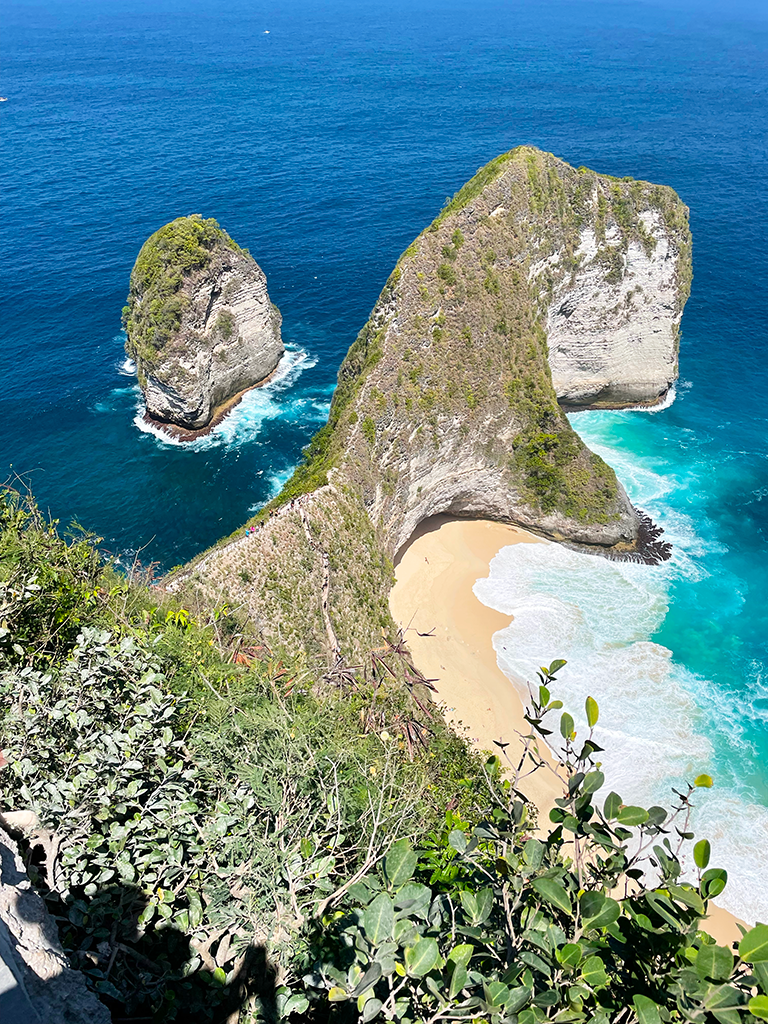
Tips for Trips: For the more adventurous, it is possible to descend to the beach by following a steep and rather challenging path of wooden ladders and ropes, but this requires a lot of time, attention and good physical fitness. In addition, the beach is described as one of the most dangerous in the world because of the strong currents.
In the afternoon, we stop at Crystal Bay in the western part of the island, a quiet bay surrounded by coconut palms, with a long white sandy beach and calm waters, ideal for swimming and snorkelling. The seabed here is particularly rich in coral and marine life: it is possible to spot colourful fish, sea turtles and, for the lucky ones, the majestic manta rays that frequent these waters.
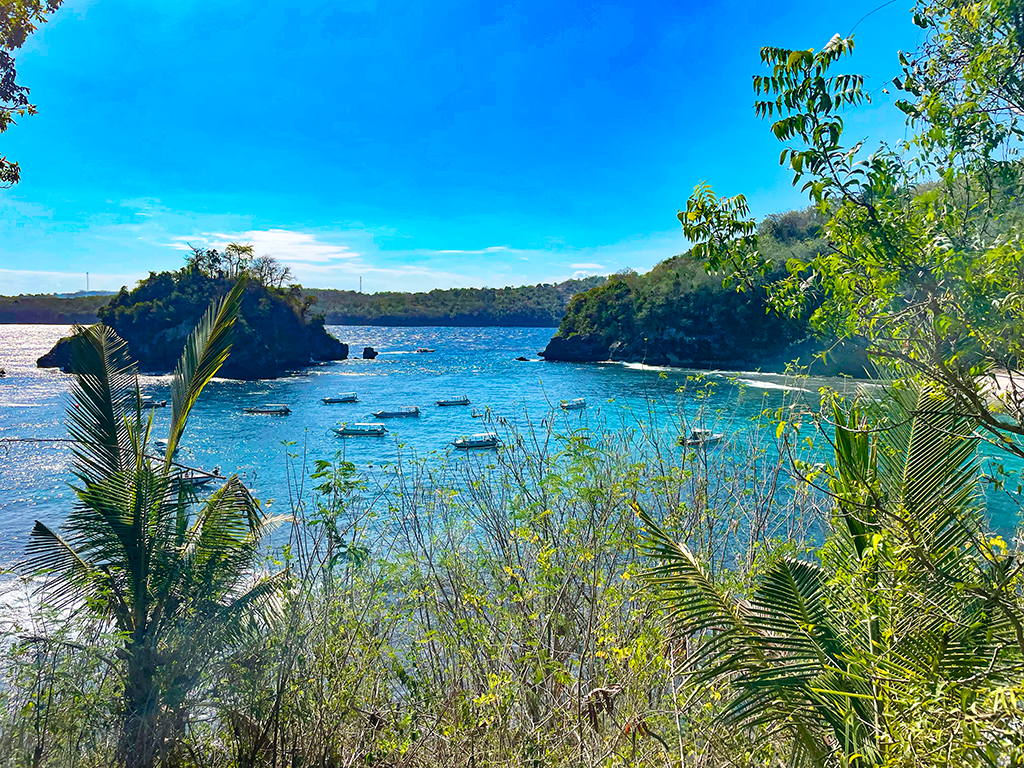
Day 8: Bali – The East
Let’s explore the east. Our day starts early as we make our way to the majestic Lempuyang Temple, one of Bali’s most sacred temples, situated on top of a hill with breathtaking views. The temple’s most iconic feature is undoubtedly its famous ‘Gate of Heaven’, a huge stone structure that seems magically suspended in the clouds, creating an almost unreal effect, as if floating between heaven and earth, perfectly framing the mighty Mount Agung in the background.
Trip for Trips: with the entrance ticket they also give you the number for the most absurd queue: the place is packed with people waiting for hours to take the famous photo in front of the doors. A local guide with a mirror creates the magical ‘water mirror’ effect. Estimated waiting time in high season: three to four hours. Is it worth it? In our opinion, no!
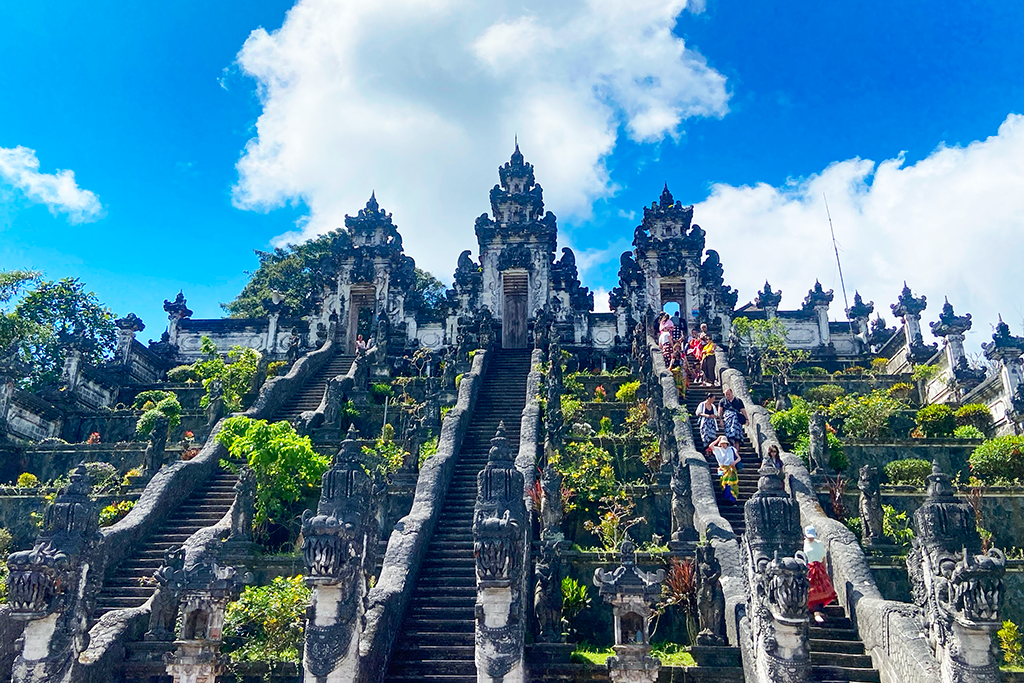
We make our way to the Tirta Gangga Gardens, an ancient Balinese royal palace transformed into a water garden. The complex consists of a series of pools, multi-level fountains and stone-carved statues. We stroll along the paths winding between the pools, crossing the small bridges connecting the ponds and hopping on a series of stone slabs arranged to form a path through the water.
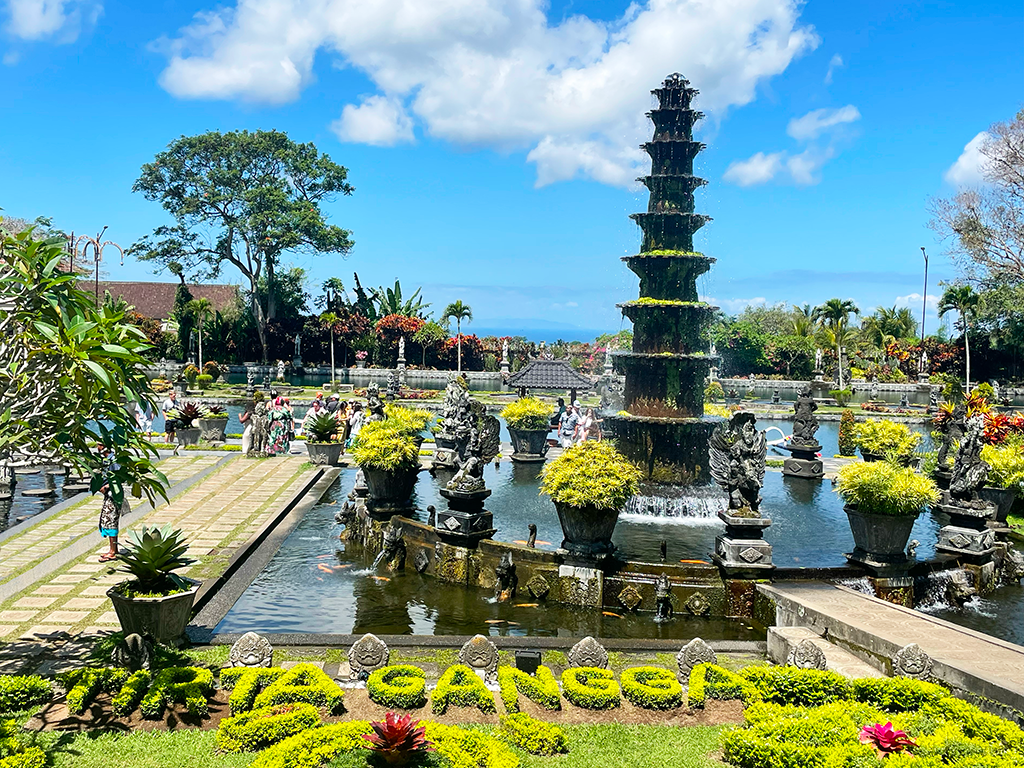
After lunch, we head for the beautiful Virgin Beach (in hindsight it would have been better to have lunch directly on the beach). The road to get there is a bit of a mess, but once we arrive, we are immediately struck by the wild beauty of the place. The beach is a long stretch of fine white sand, framed by lush vegetation and lapped by crystal-clear waters that fade into different shades of blue with a rocky coastline surrounding it.
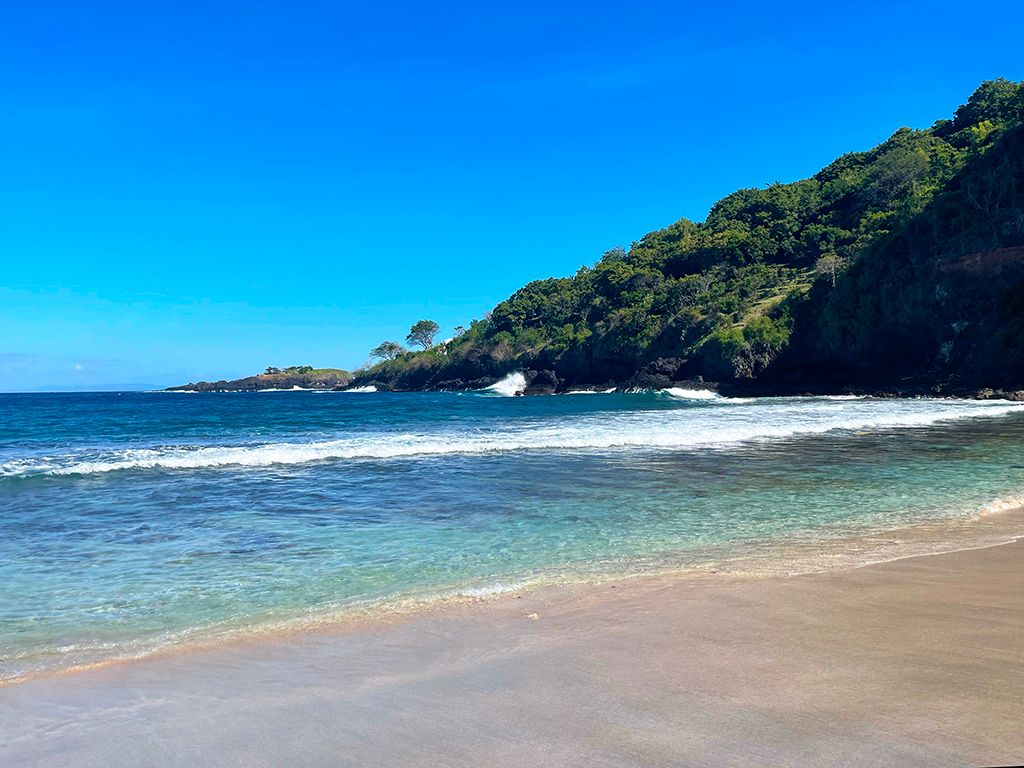
On the way back, we come across a parade of Independence Day celebrations. Celebrated in the days around 17 August, they are an explosion of colour, culture and patriotism, mixing national pride and Balinese traditions. The streets are filled with students, local communities and cultural groups parading in traditional dress or uniforms, with the Indonesian flag flying to the beat of marching bands for 45 kilometres.
Day 9: Bali – The South
We dedicate our last day in Bali to exploring some of its most iconic temples, but not before making an obligatory stop!
Our first stop is the Sangeh Monkey Forest, an ancient sacred forest inhabited by hundreds of monkeys. We arrive early, and as the monkeys have not yet eaten, they give us bags full of peanuts. A guide follows us to accompany us and take photos. The monkeys are everywhere: they jump between the branches, approach us curiously and interact with us. They are much kinder and friendlier than those in the Ubud Monkey Forest, they let us touch them and play with us. The experience is among the best memories Bali leaves us with.
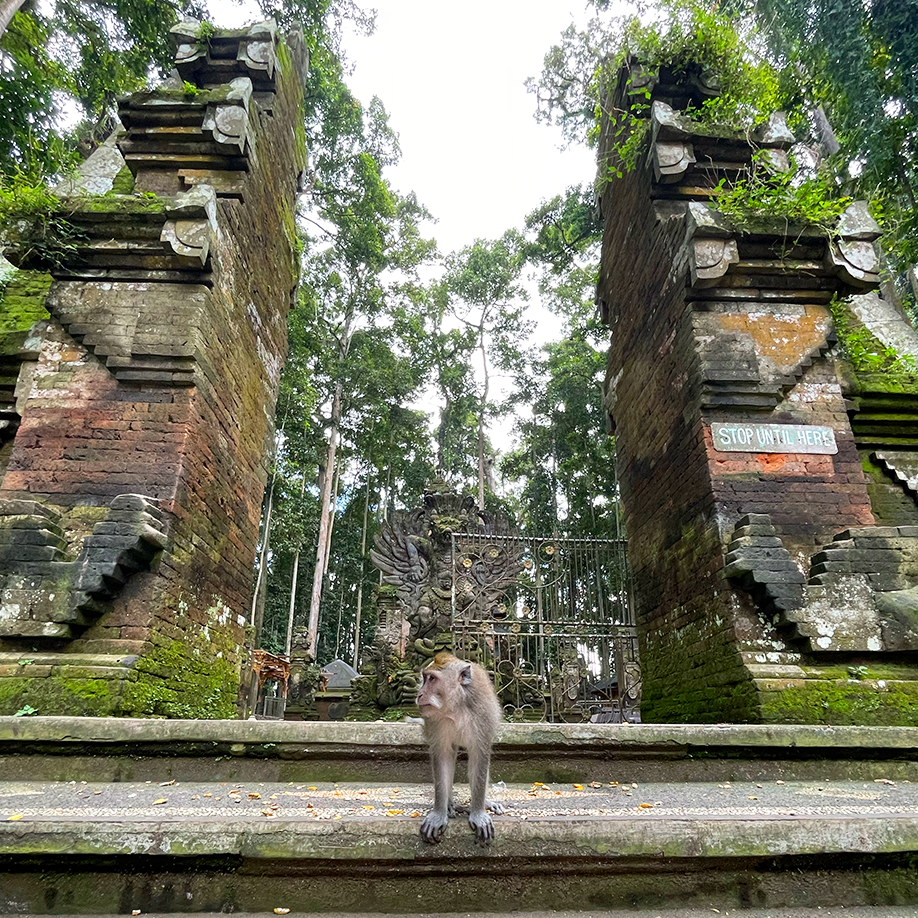
We move south to the majestic Taman Ayun Temple, built in the 17th century by the Mengwi royal family, and surrounded by a large moat and impeccably manicured gardens and courtyards. The Meru towers, with their multi-tiered roofs, rise majestically, creating an image of perfect symmetry and beauty.
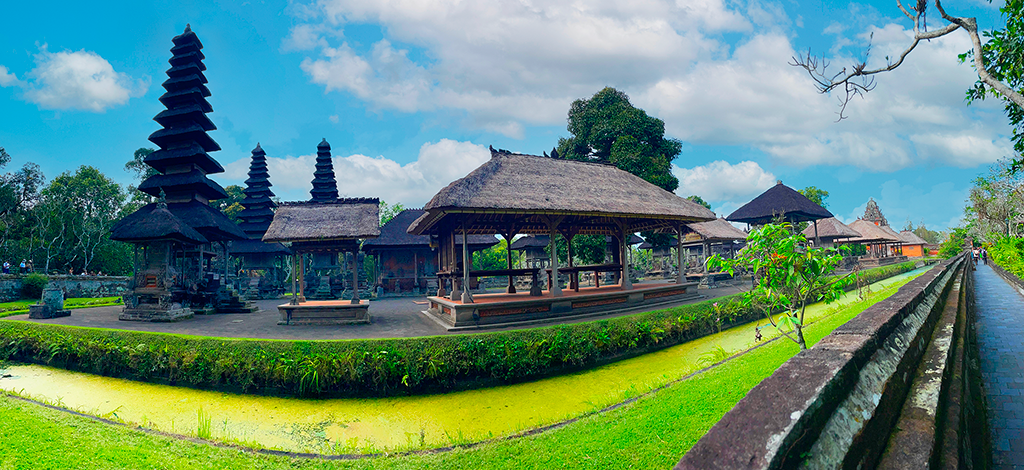
We move on to two of the most unusual temples found in Bali. We start with the Batu Bolong Marine Temple, located on a cliff overlooking the sea. The special feature is the natural arch formed in the rock, creating a suspended passage to the temple. Walking along the cliff with the view from the temple, which opens onto the ocean, is really special.
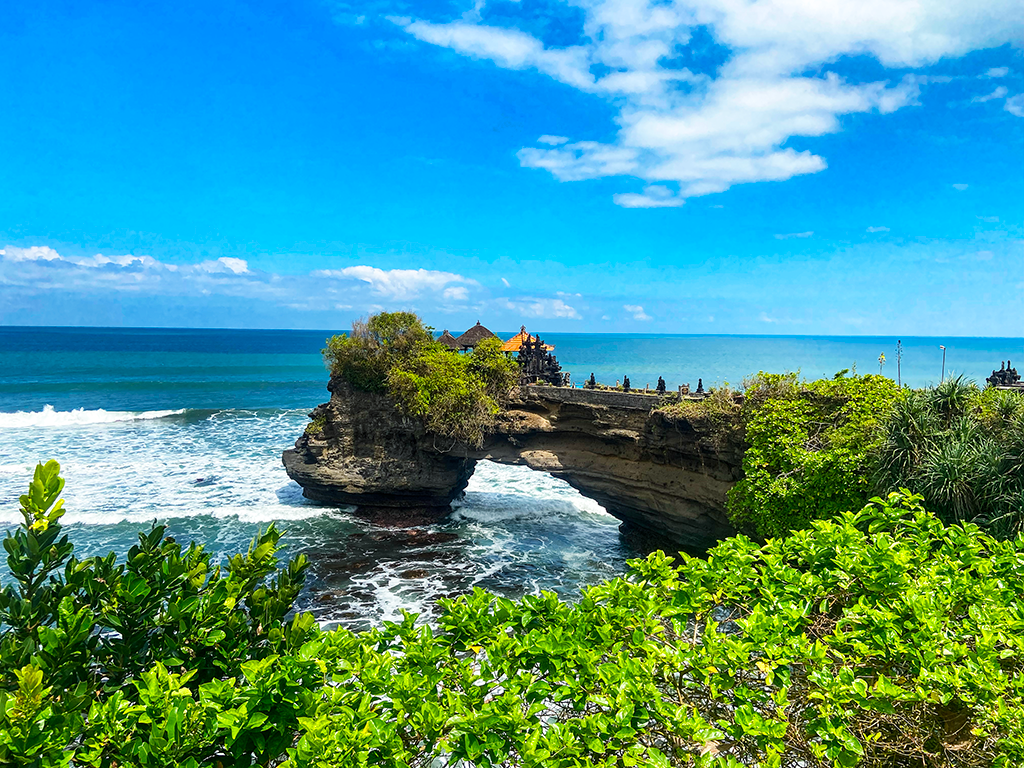
On the other side of the cliff is the famous Marine Temple of Tanah Lot. The temple is situated on a rock in the middle of the sea and can only be reached at low tide. Its location makes it a unique place.

Day 10: Bali to Lombok
Today’s second moving day, we say goodbye to Bali and move on to Lombok.
Arriving in Lombok, we come across another independence celebration parade. The streets are filled with sasaks parading in traditional dress, accompanied by processions of boys and girls playing local instruments such as the gendang. Schools participate with groups of students in colourful uniforms, performing marches and choreography. Representations of the island’s different ethnic communities also take part.
When we arrive it is already late afternoon, aperitif time! All that’s left is for us to relax and enjoy the most beautiful sunset of the entire holiday: the resort bar offers a spectacular view of Bali and the Agung volcano.
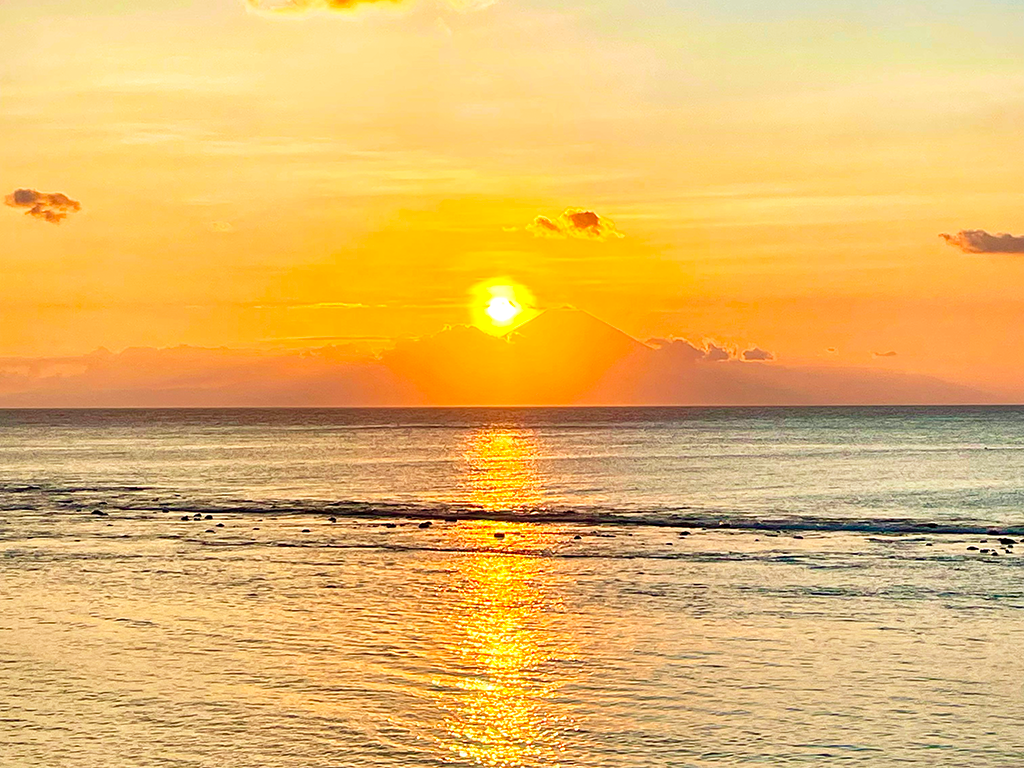
Day 11: Lombok – Gili Air
For this first day in Lombok, we booked a private tour to spend a day on a boat in the Gili Islands.
This eight-hour tour took us to the beautiful islands of Gili Trawagan, Gili Meno and Gili Air. Here we did guided snorkelling swimming among colourful fish, beautiful sea turtles, corals and underwater statues. One of the most fascinating experiences of the whole holiday: NEW PASSION Unlocked!
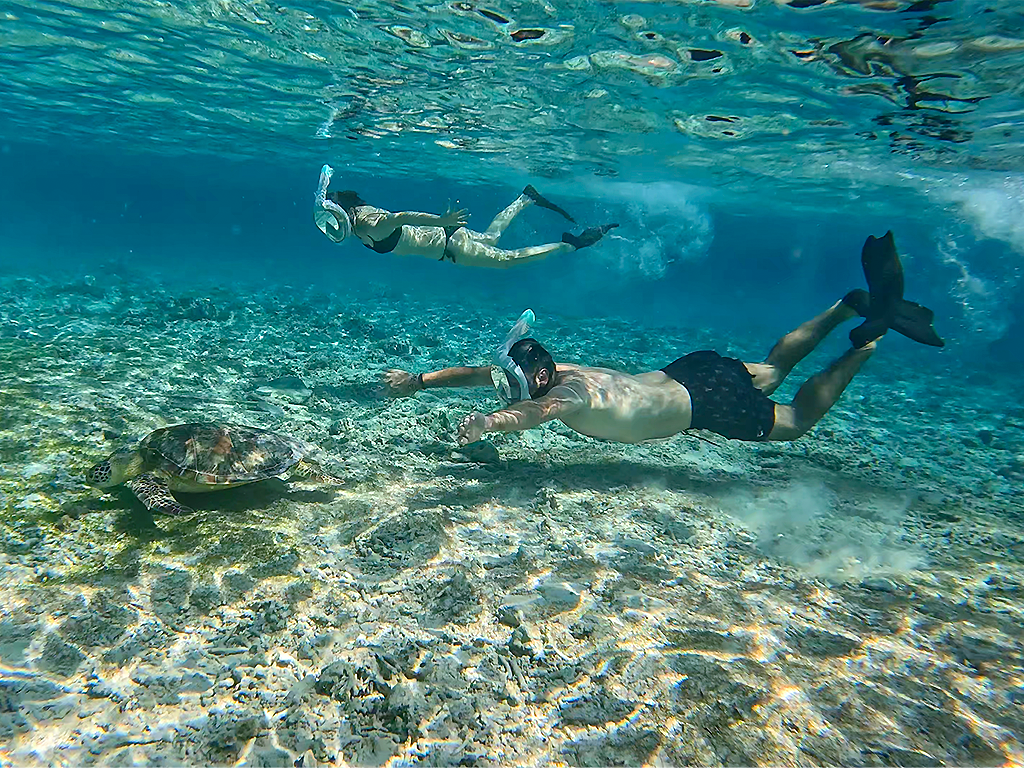
Day 12: Lombok – Mount Rinjani
For the next four days in Lombok, we turned to Gus Lombok Driver whom I would highly recommend to anyone wishing to explore the island. Gus was not just a driver, but a true guide, attentive and helpful, who was able to enrich every moment of our trip. During our time together, Gus introduced us to the local area and traditions. With great passion and competence, he told us stories, anecdotes and legends, making us discover not only the most beautiful and hidden places of Lombok, but also the authentic soul of its culture. His ability to organise the itineraries in a precise and punctual manner made each day impeccable, without ever letting us feel the pressure of time.
We start the day by immersing ourselves in local life with a visit to the Tanjung Local Wet Market, one of the most characteristic markets in the area. We strolled among the stalls to get acquainted with the flavours and scents of Lombok, and discovered typical Indonesian cuisine.
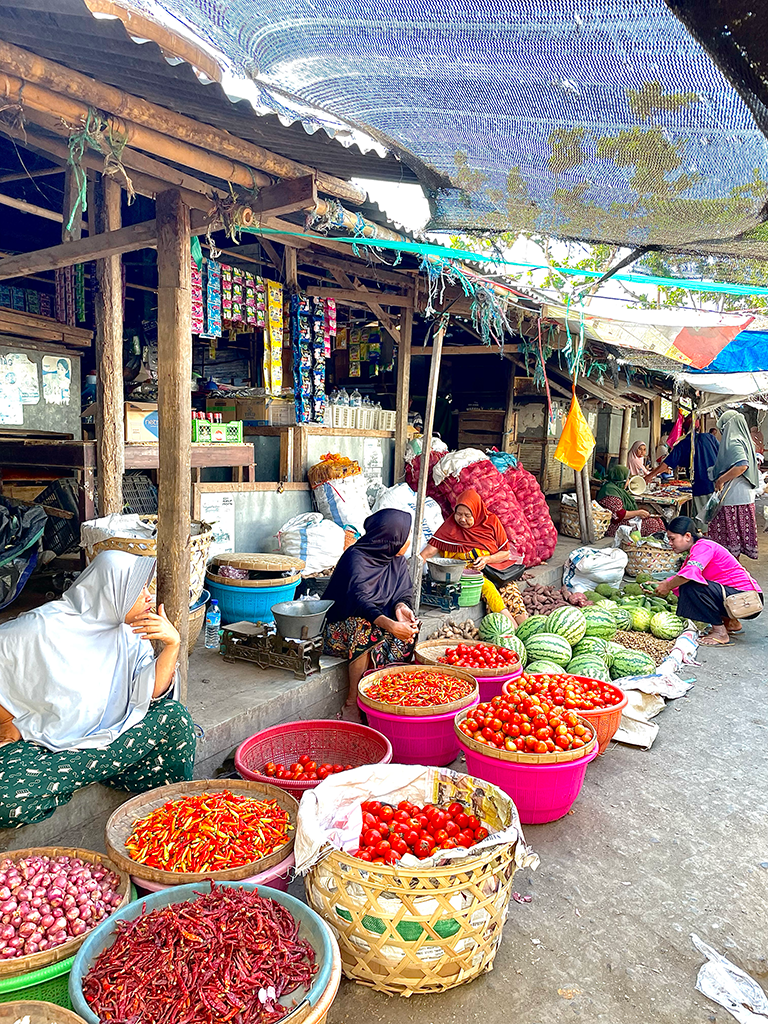
After visiting the market, we moved north to the Sendang Gile Waterfalls, in the nature park at the foot of Mount Rinjani. A scenic walk along a path of steps led us to the base of the waterfall.
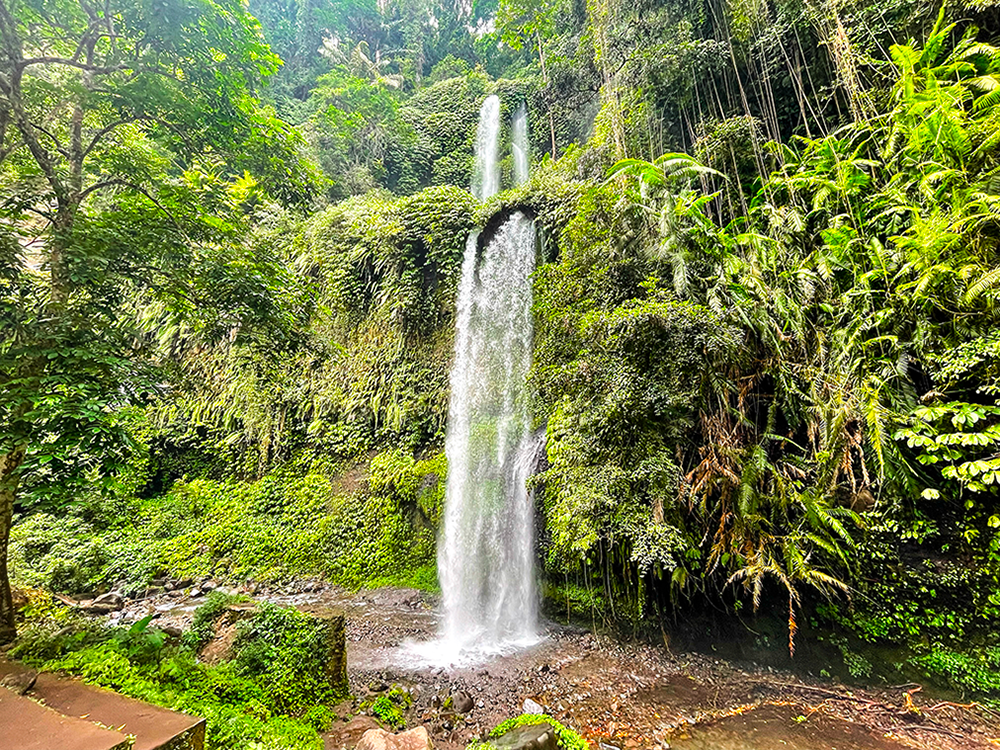
We continue on our way to the second waterfall of the day, the spectacular Tiu Kelep Waterfall. Reaching it requires a more adventurous but easy walk, crossing the river and a jungle path, but the effort is worth every step. The view of Tiu Kelep, with its waterfall rushing down between rocks and moss, is simply magical. The force of this waterfall enchants. The pond at the base of the waterfall is perfect for a rejuvenating swim, surrounded by wilderness.
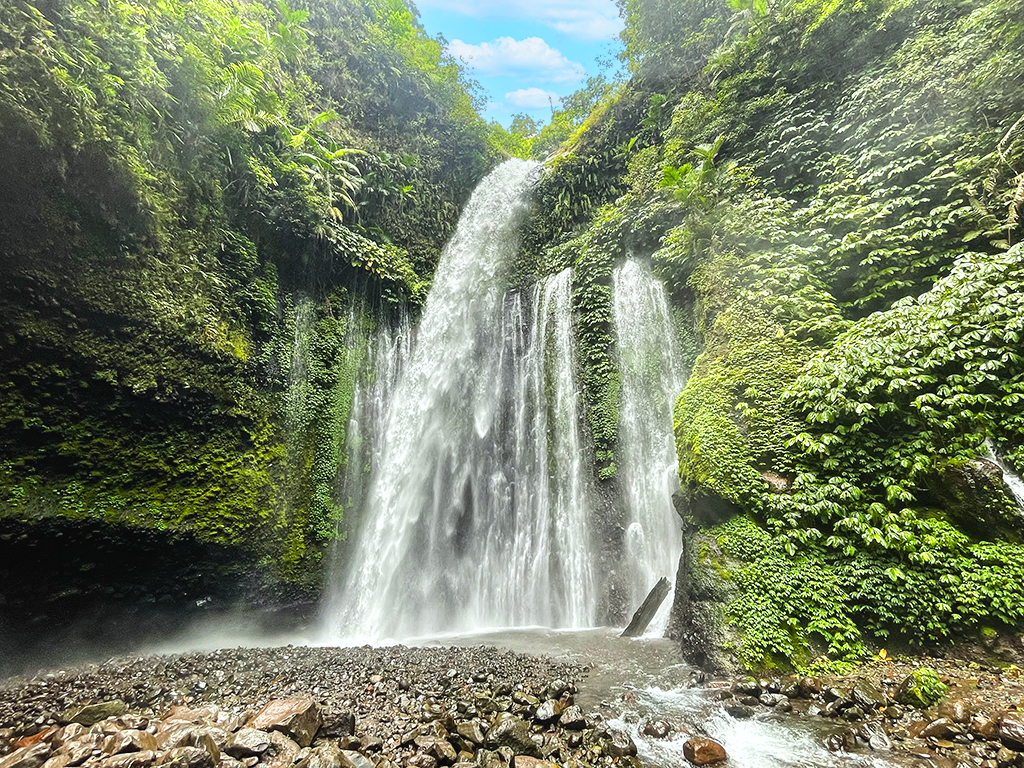
After exploring the waterfalls, we stop at Senaru Village, a traditional Sasak village. A girl from the village acts as our guide and tells us about the life and traditions of her village. We walk among the traditional houses built from natural materials and observe the inhabitants going about their daily lives. ‘Less is more’ takes on a whole new meaning here!
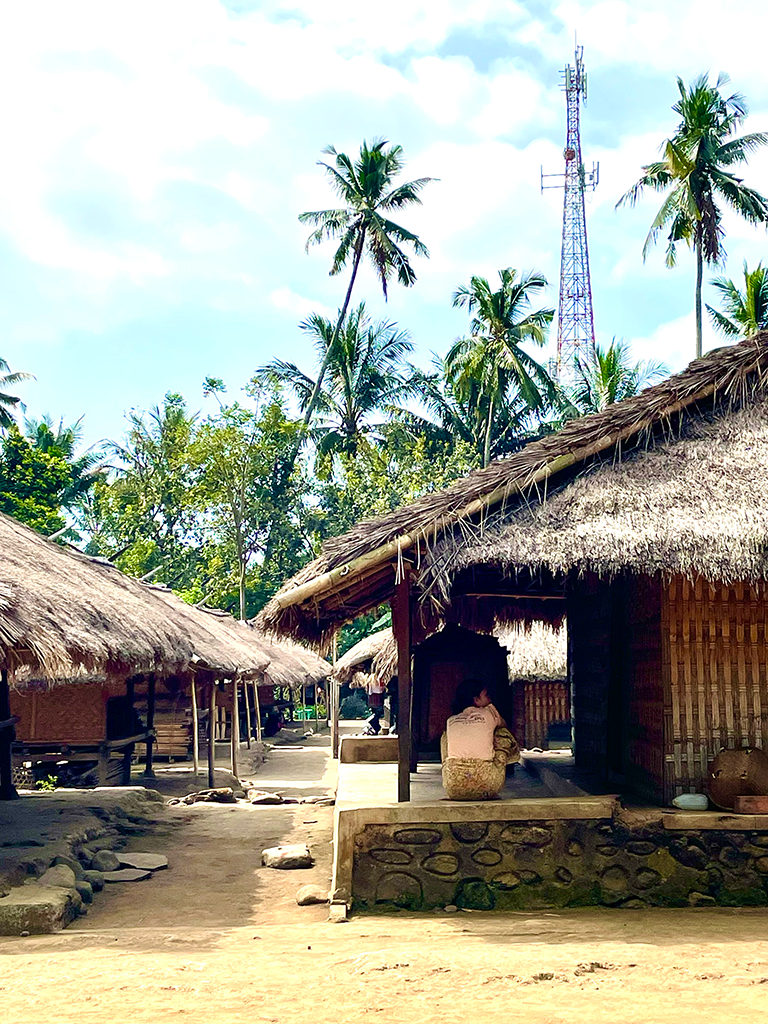
We end the afternoon with a walk through the Bayan Rice Terraces, a splendid example of terraced agriculture. Green rice fields stretch across gentle slopes, creating a picturesque landscape. Farmers still work the land using traditional methods. Walking between the terraces offers a unique perspective of rural life in Lombok.
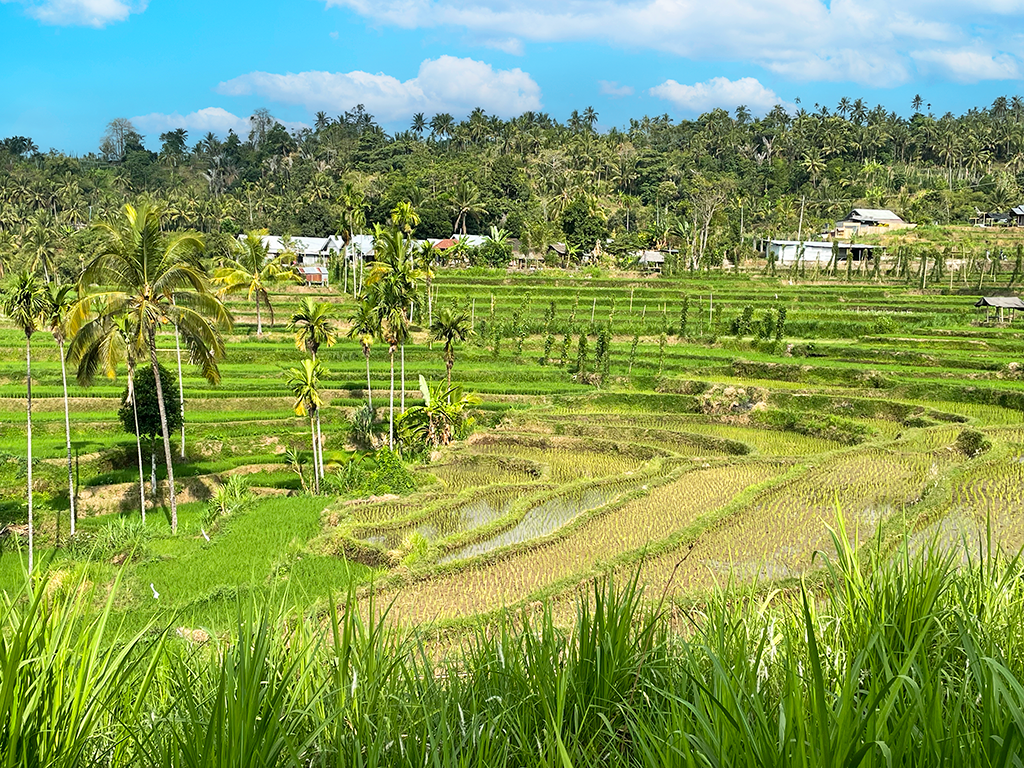
Day 13: Lombok – Tetebatu Panorama Walk
Today we explore the hinterland and in particular the Tetebatu area. We arrive at Tetebatu Village, situated on the slopes of Mount Rinjani, where our young guide is waiting for us.
We stroll through rice paddies and tobacco plantations admiring the view. We then plunge into the tropical forest to reach the Sarang Walet Waterfall. Reaching the waterfall involves a short hike through the wilderness. The last stretch is a little more adventurous: wooden bridges, paths through the water between high rock walls and boulders to climb over, but nothing too tricky. Definitely bring your rock shoes! The waterfall falls into a semi-open cave, the effect is spectacular.
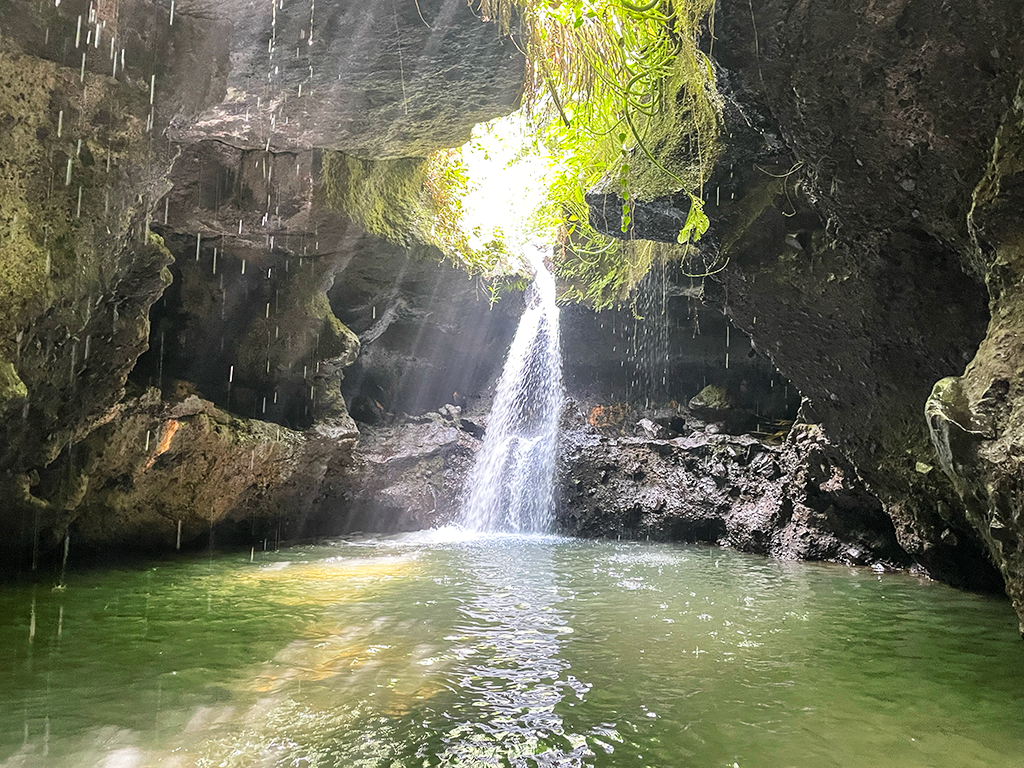
After Sarang Walet, we continue to the nearby Durian Indah Waterfall. Smaller and less frequented, Durian Indah is surrounded by durian trees, from which it takes its name. This waterfall is less frequented and is ideal for those seeking a quiet moment.
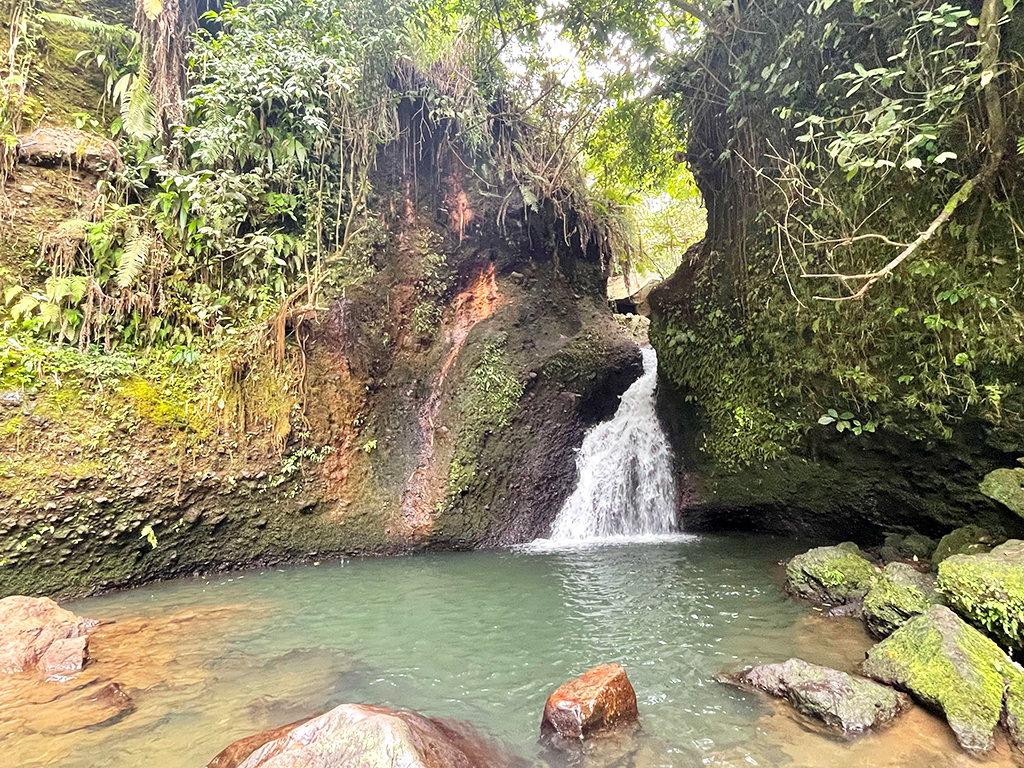
Before heading back to the village, we enter the forest for one last mission: to spot the Black Monkeys, the local monkeys that live wild in the forest. We walk up and down the forest for a long time and finally spot some. Being wild, they do not come down from the trees and do not usually interact with humans. The guide explains that he does not give them food because it makes them aggressive. They cohabit in this wonderful place, each with its own nature.
On the way home we stop in two small villages to have two very local experiences:
- Loyok Village, famous for its bamboo handicrafts, is a perfect destination to discover the skills of local craftsmen, who create bamboo objects and decorations using traditional methods. We visit a workshop and watch the manufacturing process. We also try our hand at making something, but with very little result!
- the Village of Sukarara, renowned for its traditional ‘songket’ weaving, an art handed down from generation to generation. The village women use large wooden looms to create textiles with very intricate designs. We observe the weaving process, try to grasp the techniques and dabble in the weaving – good but not great!
Day 14: Lombok – Southern Beaches
Today is a day dedicated to the sea around Kuta, discovering huge, white and often almost deserted beaches.
First stop is Mawun Beach, one of the quietest and most picturesque beaches on Lombok’s south coast. The semi-circular bay is framed by green hills, and the turquoise waters are perfect for swimming or simply relaxing on the soft sand. Not being very crowded, Mawun is ideal for enjoying some peace and quiet.
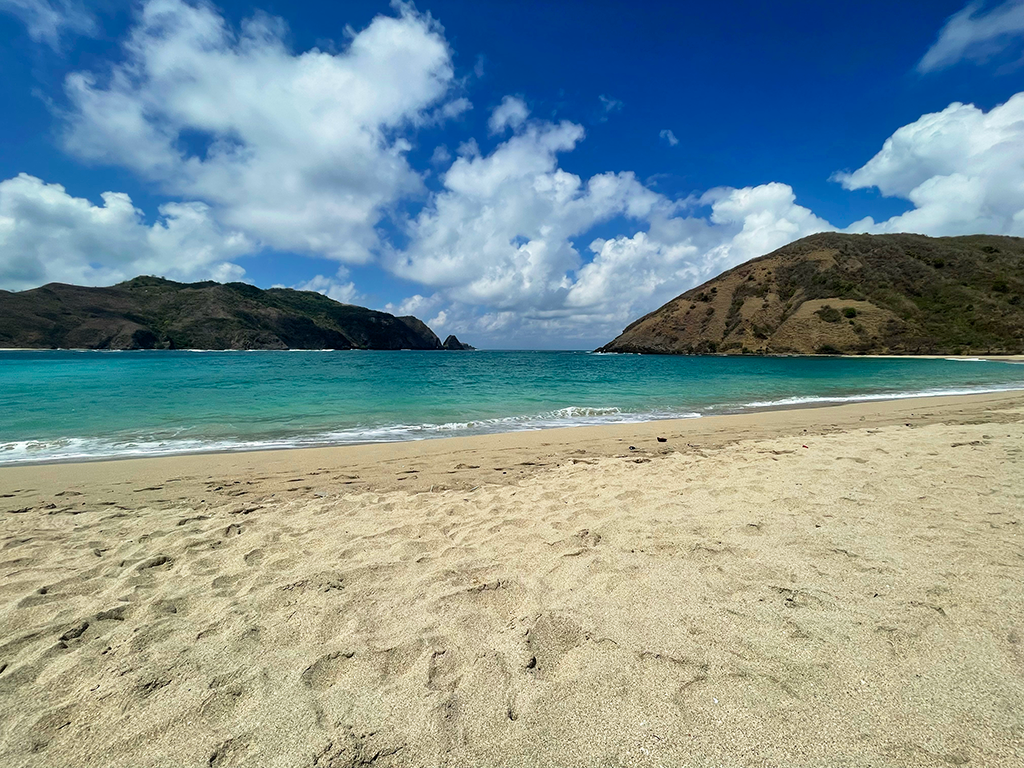
Before lunch we move on to Selong Belanak Beach, one of Lombok’s most famous beaches and our favourite of the whole holiday! The photos don’t do it justice but it is one of the most spectacular beaches on the south coast, with its long stretch of fine white sand surrounded by green hills.
Here we enjoy an excellent lunch overlooking the sea and take our time to enjoy the natural spectacle on offer.
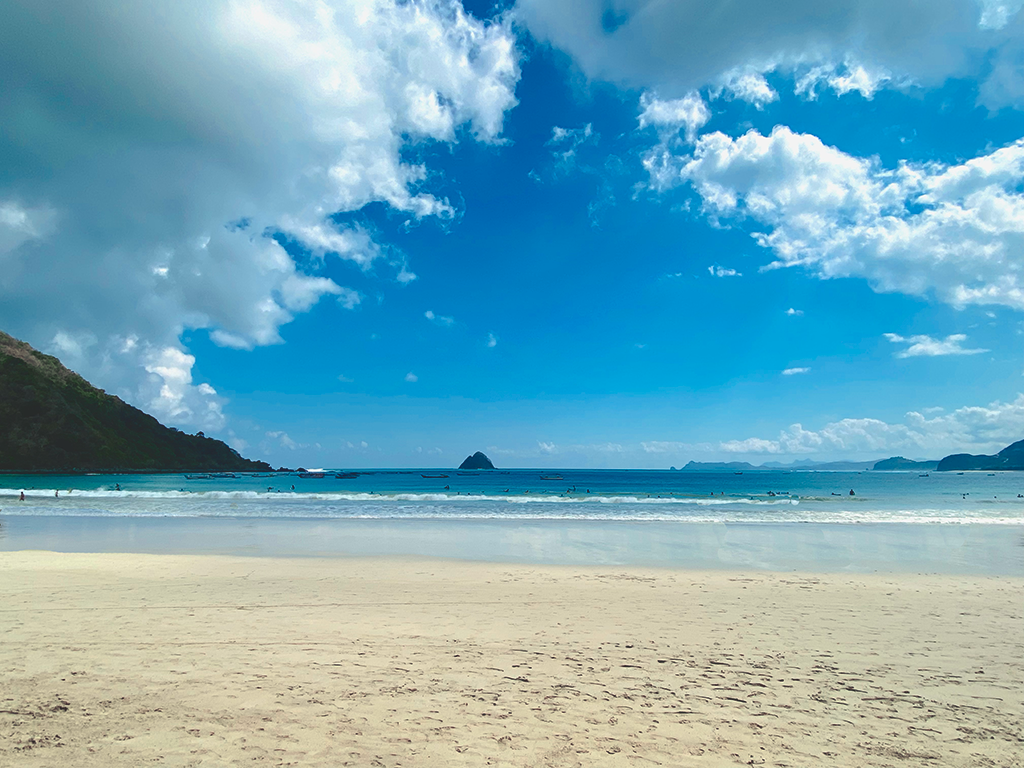
We move on to Tanjung Aan Beach but it is not what we expect: the tide is very low and the beach is full of seaweed creating almost an impermeable layer. We take a walk and are pleasantly surprised by what looks like a meadow with small saltwater ponds, which allows you to almost reach the centre of the bay. The view of the ‘sea meadow’, the transparent sea and the boats stranded on the sand creates a very impressive and unrepeatable panorama.
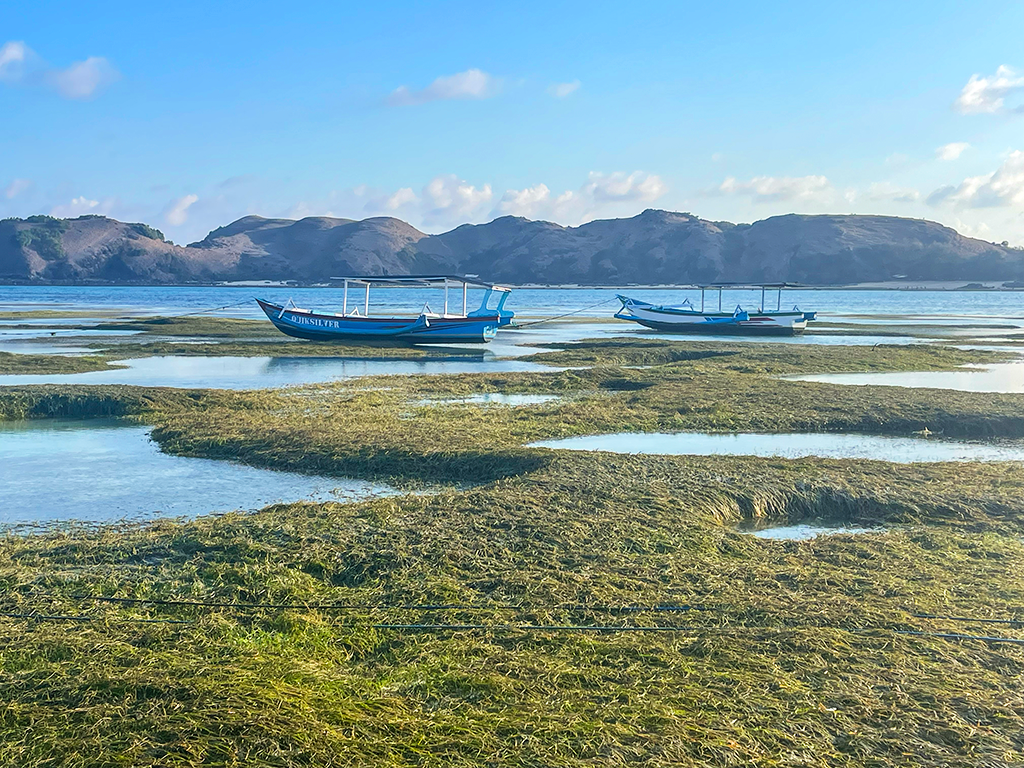
Located very close to the beach is the Merese Hills Sunset Viewpoint. After a short walk over the grassy hills, we reach the summit where there are numerous viewpoints. From the summit there is a view of the entire coastline and we can admire the sun slowly dipping into the ocean, colouring the sky in shades of gold, pink and purple. We are not very lucky, the sky is cloudy but gives us some appreciable shades.
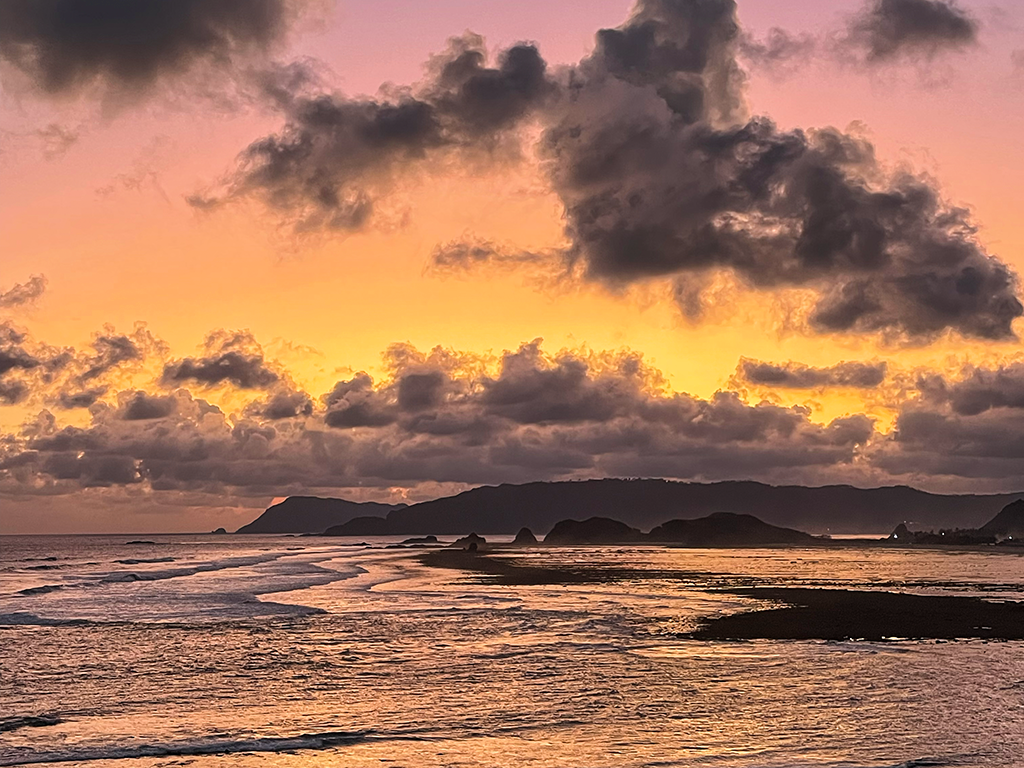
Day 15: Lombok – Secret Gili (South West)
For this last day on the island, we decided to end on a high note: we travelled with our friend Gus to the Sekotong peninsula and the Secret Gili. They are located in the south-west and are called “Secret Gili” or more simply “Southern Gili“: they are much less known and frequented than their famous sisters in the north but are an equal snorkelling paradise with less mass tourism.
We boarded a small private boat and went snorkelling in the most beautiful spots between the Gili Goleng, Gede Layar and Asshan islands. Here we spent one of the most beautiful days of the whole trip swimming among colourful fish, electric blue corals and starfish, turtles… and we even managed to spot a seahorse!
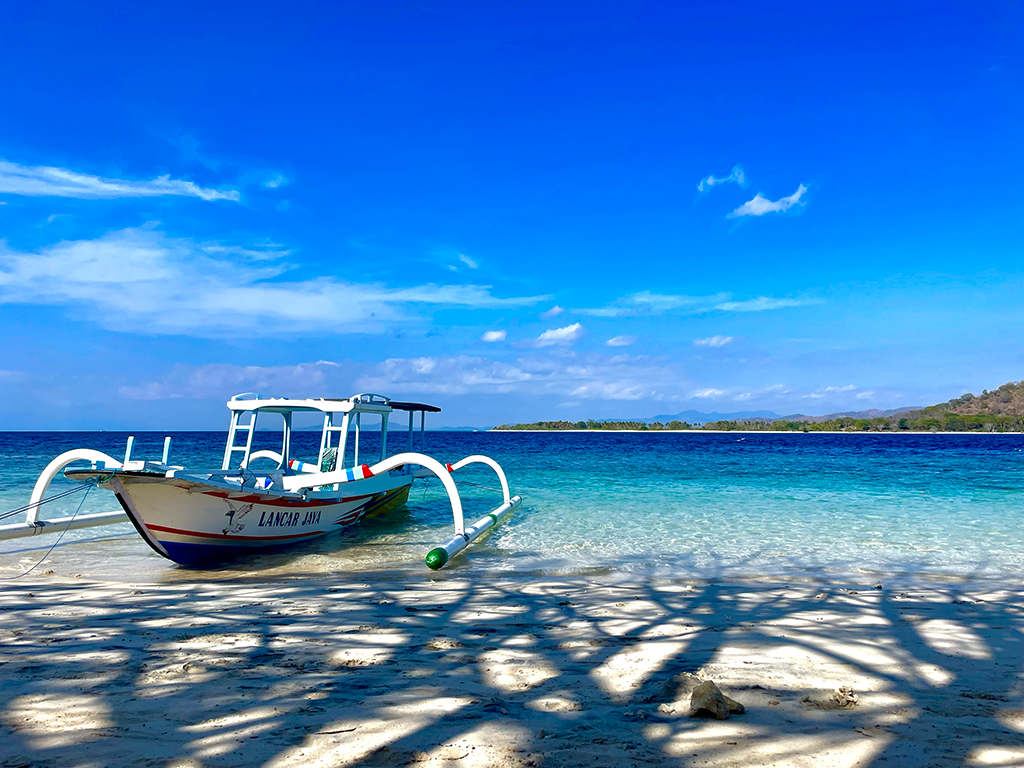
For lunch we stopped on the island of Gili Layar, where in a small restaurant directly on the beach we were served a hearty and delicious lunch. One of the tastiest fish I have ever eaten!
Our wonderful last day in Lombok draws to a close and when we arrive at the hotel our friend Gus offers to take us to the airport the next day, it is truly rare to find people of this kindness.
Day 16: Return to Milan
As agreed, Gus picked us up from the hotel and took us to the airport. We said goodbye as one does with friends and he even left us a gift from his wife!
***
Our journey through the wonders of Indonesia comes to an end, but the memories of this adventure are strong. We take home the image of temples bathed in mist, the crystal-clear waters of the islands, the smiles of the people we met and the flavours of the local dishes.
We hope that the charm and magic of these faraway islands will inspire you on an upcoming trip to discover wonderful corners of this extraordinary archipelago.
Last modified: 13 June 2025
